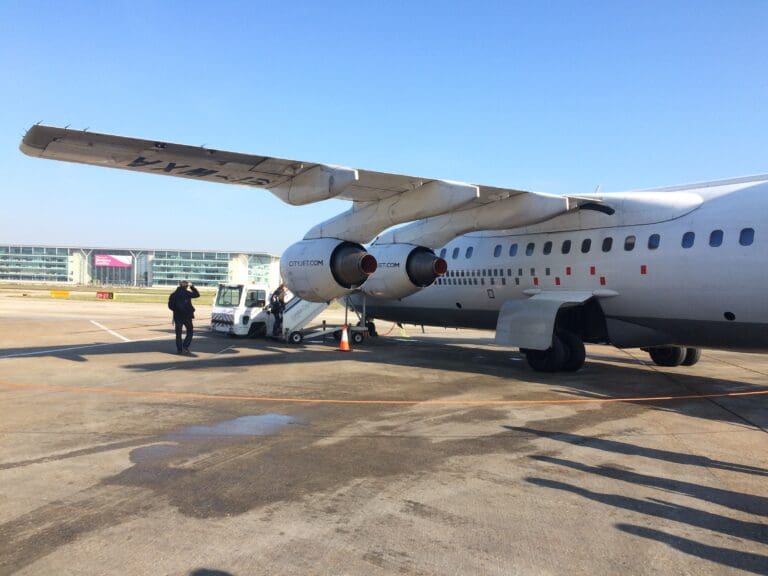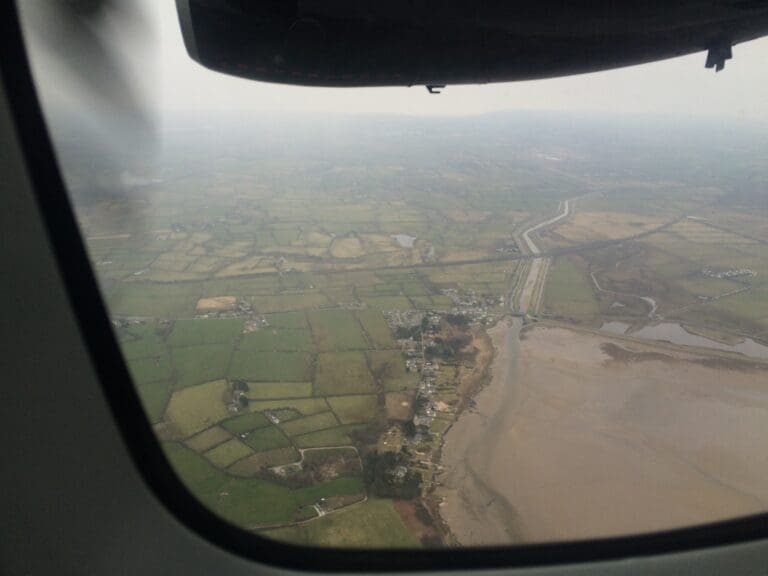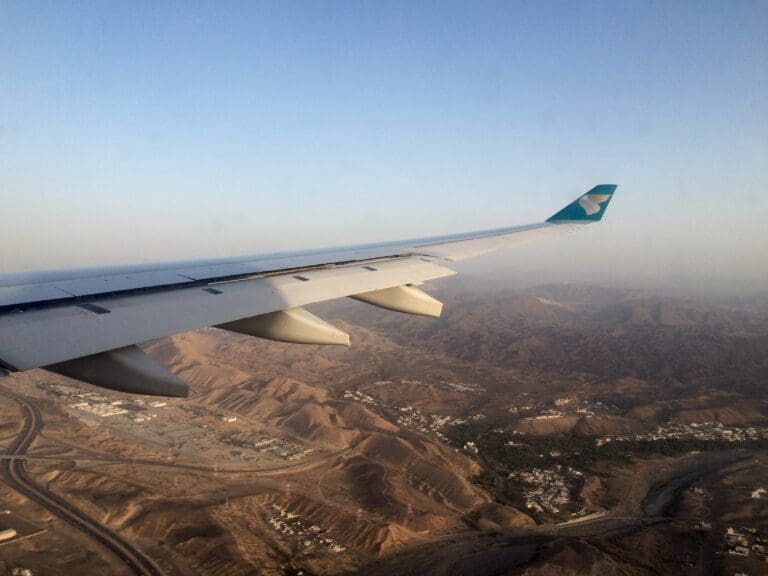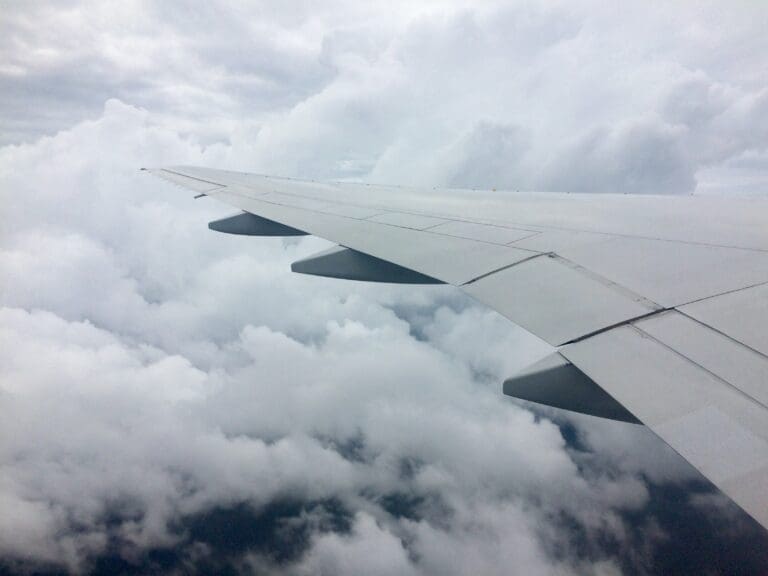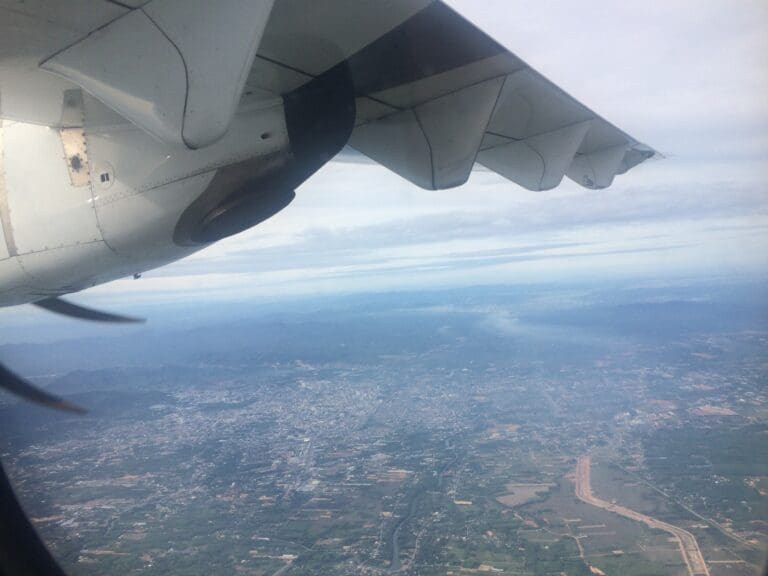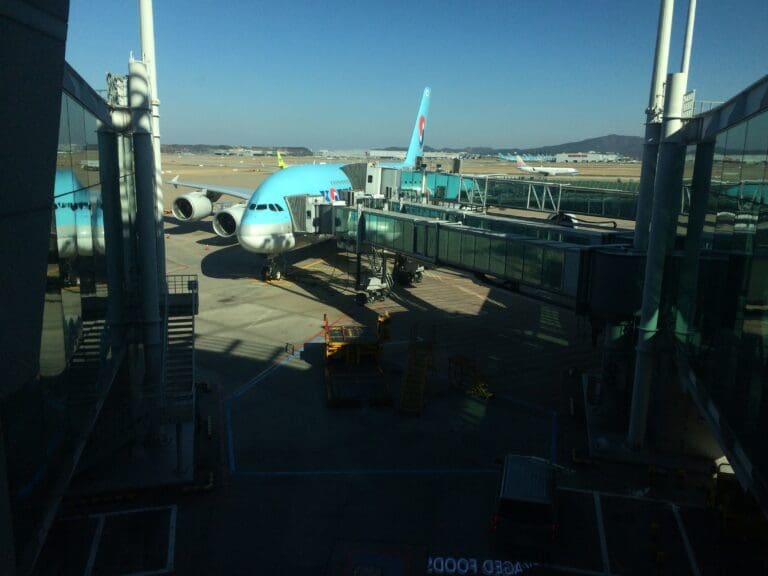Experiencing China’s Rare Turboprop: Yantai to Dalian and back on a Joy Air Xian MA60
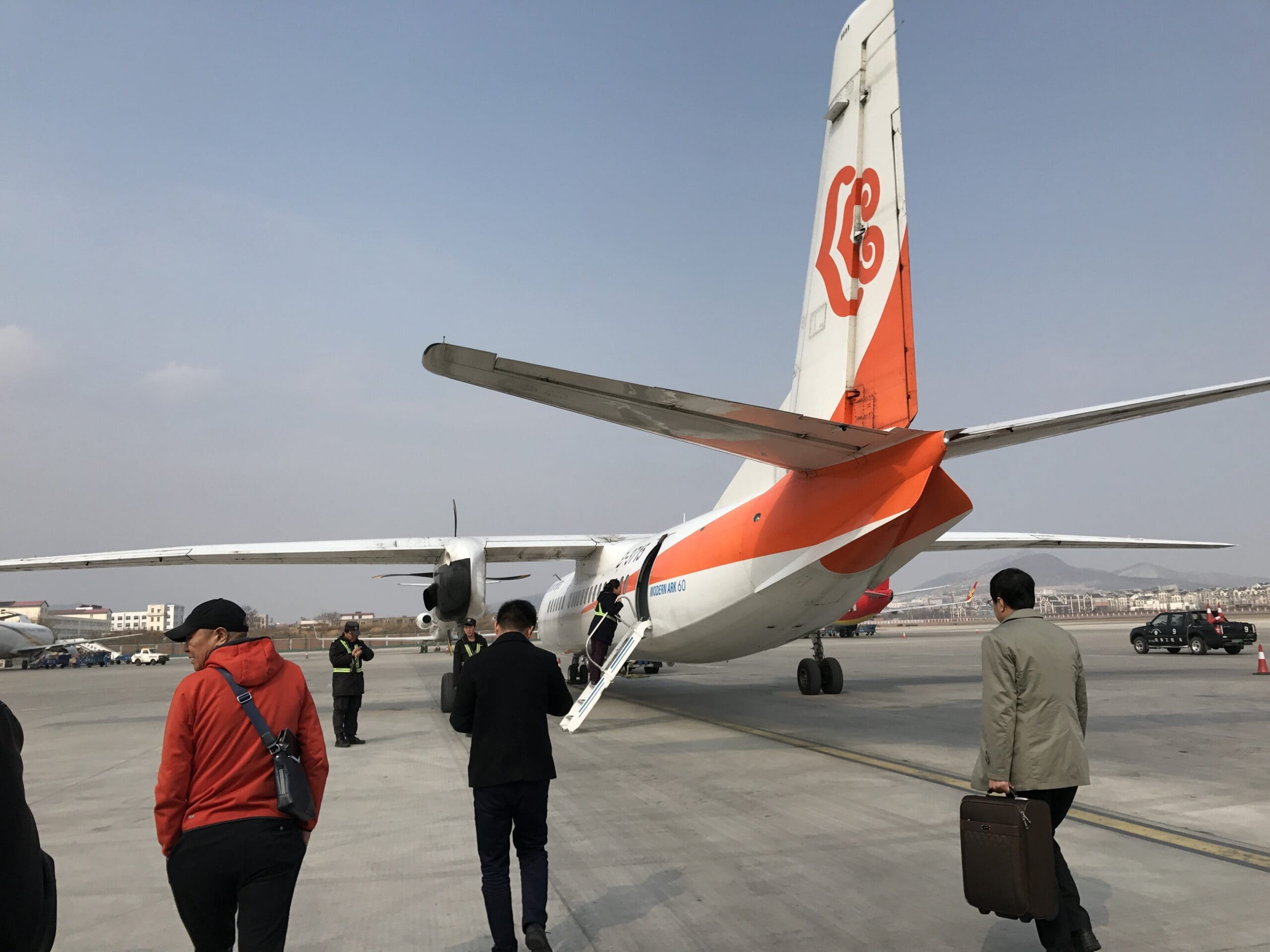
Background
On a frozen evening in February 2017, I touched down on Chinese soil at Yantai Penglai International Airport following a short flight from Korea onboard a Chinese Eastern Airlines Airbus A320. As the Chinese-manufactured Airbus taxied over to the airport’s modern terminal building, I caught sight of a twin turboprop airliner basking in the glow of the airport’s orange floodlights. At first glance this resembled the Antonov 26s that I used to see regularly as a child at East Midlands Airport back in the UK, however, this was certainly no Antonov! Instead, this was the Chinese Xian MA60, and was being prepared for its evening flight to Dalian. This was operated by the joyous Joy Air, although somewhat confusing sported to the livery of the more mediocre Okay Airways.
Whilst the Xian MA60 was an aircraft type that I was aware of, this was my first encounter with this rare aircraft type and I most certainly did not assume that I would ever get the opportunity to fly on this uncommon airliner. On my return journey from Okinawa to Seoul, during a short stop in Nanchang (yes, an odd routing I know!), another Joy Air Xian MA60 arrived and inspired me to proactively attempt to sample a ride onboard one of these turboprop airliners. Living in Seoul, the easiest means for me to do this was to head to Dalian or Yantai, from where I could catch a ride across the Bohai Strait to the other. With tickets for this service costing just $24 in each direction, I could hardly pass on the opportunity to sample this rare aircraft.
At first I planned a triangular route flying from Seoul Incheon to Yantai, where I would spend a night in the local airport hotel before flying onwards to Dalian for a night there before returning to Seoul Incheon. However, I found flight prices from Dalian to Seoul Incheon to be rather extortionate given the short duration of the flight between the two, with flights between Korea and Yantai proving to be much cheaper. I thus instead booked a return flight from Seoul Incheon to Yantai with Shandong Airlines for around $120, d Dalian are separated by just 85 miles, and and a return flight from Yantai to Dalian with Joy Air. Interestingly, despite the fact that Yantai and Dalian are separated by just 95 miles and with regular ferries ploughing between the two, there are plenty of flights between these departing at all times of day. Those who don’t wish to fly onboard local metal can instead fly with China Eastern Airlines or Qingdao Airlines who both deploy the Airbus A320 on the route, Jiangxi Air who operate the Boeing 737-800, or Tianjin Airlines who fly this with an Embraer 190.
Unfortunately, as seems to be the case with all Chinese airlines that aren’t one of the big three or Xiamen Airlines, booking a ticket via Joy Air’s website without any knowledge of Chinese and a Chinese payment card appeared to be an impossibility. Thus, I decided to book via the Chinese booking site Ctrip which enabled me to book tickets and pay for them without issue.
A Little Bit More About the Xian MA60
The Xi’an Aircraft Industrial Corporation’s Modern Ark 60 made its first flight just over 17 years before my trip in February 2000. This was developed from the Xian Y-7, which was in turn based on the Soviet Union’s popular Antonov An-24, hence explaining the type’s similar appearance to this venerable type. Following its first flight, the first example was delivered to Sichuan Airlines, and the type was intended to become the workhorse of regional flying across China. However, the type’s success never really took off. Being a small regional turboprop capable of carrying up to sixty passengers, the type wasn’t quite conducive to the boom in demand for domestic air travel in China seen since the 2000s. Meanwhile, thanks to the rather intensive efforts to construct long runways across the country, there weren’t many airports where larger aircraft could not operate. Thus, of the six Chinese carriers that took delivery of the type, only one, Joy Air, operated these for more than a few years. With these deployed on routes between smaller regional cities, from bases in Xian and Tianjin.
Rather than enjoying significant local success, the Xian MA60 ended up being exported to countries across the world, often as somewhat of a diplomatic tool, serving the dual purpose of increasing linkages with countries across the world whilst providing an air transport solution. In total, sixteen civilian operators in Bolivia, Burundi, Cambodia, Cameroon, the Republic of the Congo, Eritrea, Indonesia, Laos, Myanmar, Nepal, the Philippines, Sri Lanka, Tajikistan, Tonga and Zimbabwe. However, of the fifty civilian aircraft exported overseas, only three Lao Skyways Xian MA60s have been verified as being in regular commercial operation. In addition to these, thirteen were exported to the militaries of Angola, Cambodia, Cameroon, Djibouti, Laos, Sri Lanka and Zambia.
Unfortunately, perhaps opposing its success is the Xian MA60s safety record, which can only be described as patchy at best. Of the 106 Xian MA60s produced, there have been 19 involved in notable incidents and accidents, equating to 17.9% of these aircraft. Granted, a some of these were down to pilot error and other circumstances, rather than issues with the airframe itself. This safety record led New Zealand to caution tourists against flying onboard airline Real Tonga’s Xian MA60 that had been gifted by the Chinese government. With the type not certified to fly in many jurisdictions, including those of EASA and the USA, it is safe to say that the aircraft type is one that nervous flyers may wish to give a miss!
About Joy Air
You can’t be blamed if you haven’t heard of Joy Air, after all, they are a relatively small airline with a fleet of only eight aircraft, all of which are Xian MA60s and fly to seventeen destinations across eastern China with their main hub located in the famous city of Xi’an. Given their comparatively small regional operation, unsurprisingly, relatively little can be found about Joy Air online. However I was able to discover that they commenced services in 2009 are serve as a joint venture between Chinese giant, China Eastern Airlines, and the Xian MA60’s manufacturer, the Aviation Industry Corporation of China. Despite the airline’s small size, one only needs to look at the order books to see they have great plans with 44 Xian MA60s, 50 Comac ARJ21s and 20 Comac C919s currently on order.
Update
Joy Air eventually shifted their operating model from short haul operated hops with the Xian MA60 to longer flights between regional cities across China with five Boeing 737-800s. The airline still operates at least three Xian MA60s, and, as of 2024, has the Comac ARJ21 and Comac C919 on its order books, although these are yet to be delivered to the airline
Yantai to Dalian
Following a pleasant ride with Shandong Airlines, the modern and comfortable Boeing 737-800 that had carried me across the Yellow Sea from Seoul Incheon touched down on Chinese soil just before 2200. As many of those who have visited China will be aware, entering the country is not always the quickest or most straight forward procedure, however, that day, I sailed through immigration and found myself standing in the freezing cold Shandong air in no time at all. Seeing as central Yantai sits around 43 kilometres away from Yantai Penglai International Airport, and considering my morning departure the next day, I decided to splurge out on a night at the Yantai Airport International Hotel. Sitting no more than a ten minute walk or a short complimentary shuttle ride away from the terminal, this is the only hotel on the airport grounds, and the only hotel anywhere near the airport that, thanks to registration requirements, accepts guests who aren’t residing in China.
With this being my second time staying at the hotel, I had a good idea of what to expect and I found this to be modern, clean and comfortable, ultimately proving to be more than sufficient for a one-night stay. As with my first visit, I did find this to be eerily empty and for the duration of my stay I encountered just three other visitors – two Korean China Eastern Airlines flight attendants who were presumably on a layover in Yantai in between Seoul Incheon services, and a China Eastern Airlines mechanic enjoying a hearty Chinese breakfast in the restaurant. Having seen plenty of blogs and vlogs detailing travel to North Korea, the only thing I can compare this to is one of the fancy Pyongyang hotels where an army of workers cater to a small handful of guests!
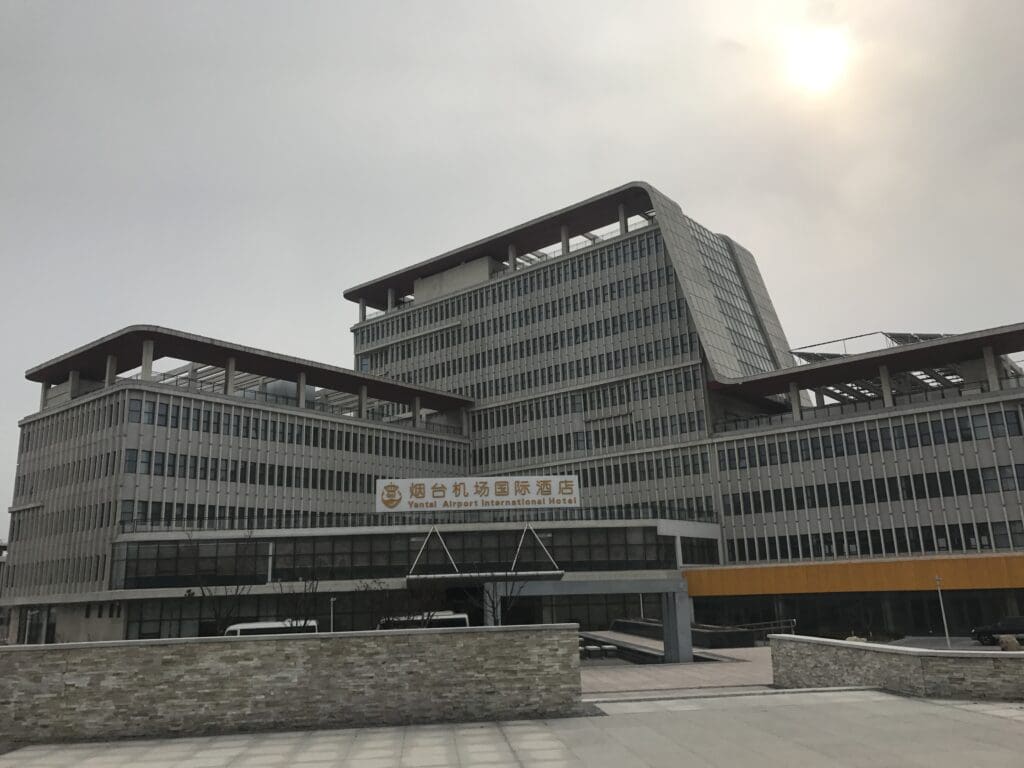
Once I had eaten plenty of rice porridge and a plethora of accompaniments, I packed the last of my things and returned to reception to check out. There, the polite staff offered me the luxury of my own private ride over to the terminal building. However, given the sunny skies and the close proximity of the terminal, I saw no reason to take them up on this offer and instead, I decided to wander over to the terminal on foot. Heading outside, I darted through the morning air which hovered around a crisp four degrees, before reaching the warmth of the terminal a few minutes later. Making my way inside, I found myself standing in the arrivals level and so I soon made my way up the escalators to the terminal’s large, spacious and modern check-in hall.
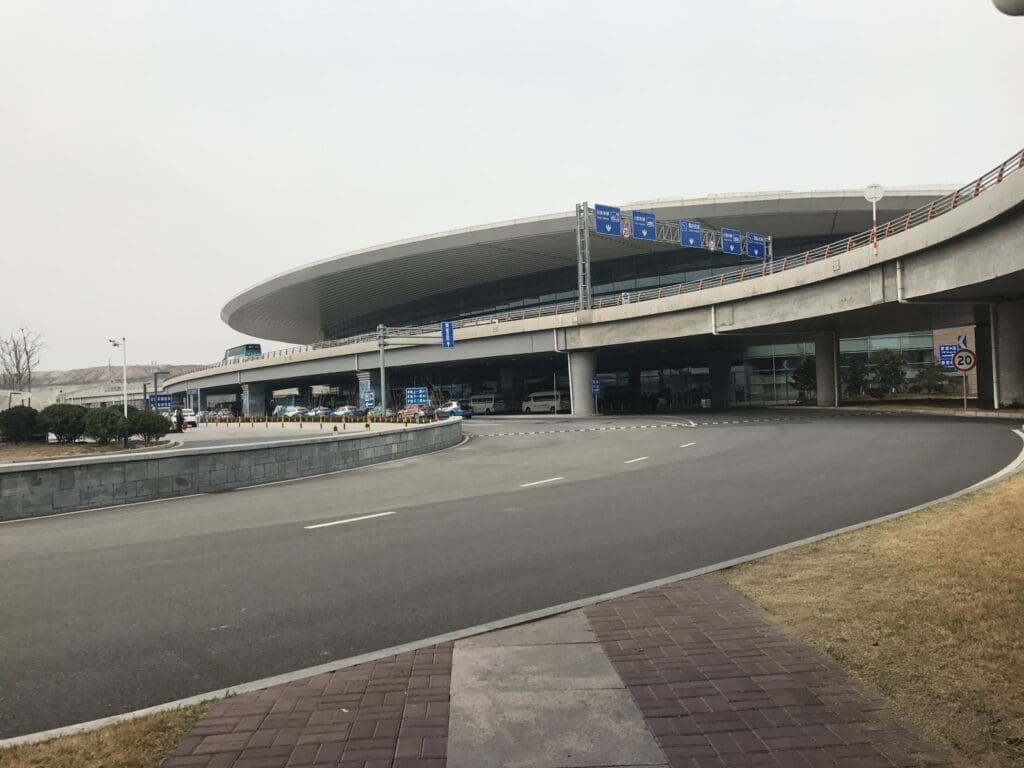
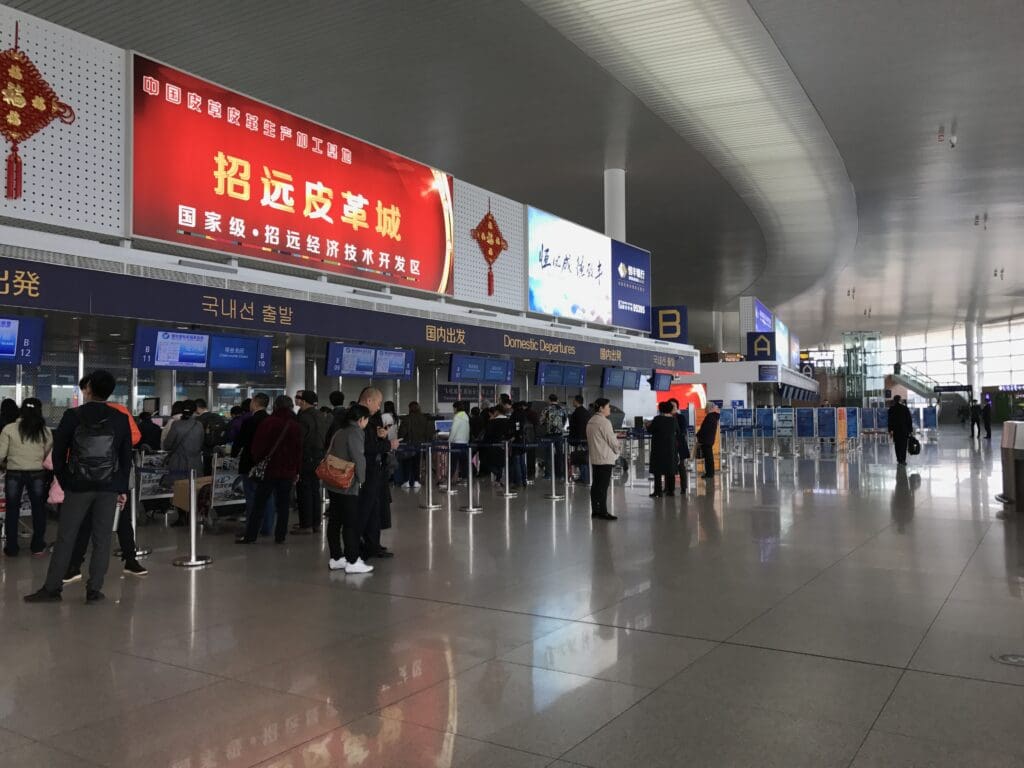
In terms of its layout, the check-in hall features three long banks of check-in desks – one for international flights, one for domestic flights, and another reserved for the exclusive use of those heading off on Shandong Airlines’ services. In addition, a fair number of self check-in machines could also be seen dotted around, however, these could only be utilised by those residing in China and departing on domestic services operated by China Eastern Airlines and Shandong Airlines. With nothing more than a short queue at the domestic check-in desks, I joined this and expected to complete check-in formalities within about ten minutes or so. Unfortunately, I completely underestimated how long it would take to check-in the mountains of luggage that virtually every passenger in front of me was carrying. Making things a little more chaotic was the fact that a few passengers behind me did not seem to take kindly to the idea of waiting in line and attempted to overtake me. After around twenty minutes of waiting and whilst in third place to check-in, the desk in front of me was closed and a mad rush to get to the neighbouring desk ensued. Now in another queue, I spent twenty minutes having my ankles rammed before I finally reached the desk. Once there, I handed over my passport and requested a window seat. After some furious typing, my Yantai Penglai International Airport boarding pass was printed off which revealed that I had been assigned Seat 4A near the front of the cabin.
With my boarding pass in hand, it was time to continue onwards and head to security. Given my chaotic forty minute wait at security, I was braced for similar chaos in order to get airside. Following a much calmer five minute queue, my passport was checked and my boarding pass scanned by a stern looking security offer in a quasi-military unofirm before I entered the security check area. As is usually the case at Chinese airports, this security check was most certainly through, however, it was also quick and I managed to get through with minimal fuss, leaving me with a fairly good impression.
As with the landside portion of the terminal, I found the airside area to be bright, modern and with the exception of the toilets, very clean and tidy. Inside, all signage was in Chinese, English and Korean, meanwhile plenty of seating was on offer throughout the terminal and for the duration of my stay, this did not seem to get particularly busy. Finally, a reasonably number of shops and cafés were offered throughout the terminal, along with plenty of hot and cold water dispensers. Unfortunately, as those who have travelled on Chinese domestic flights will likely be all too aware, connecting to the wifi in the terminal was impossible without a Chinese phone number.
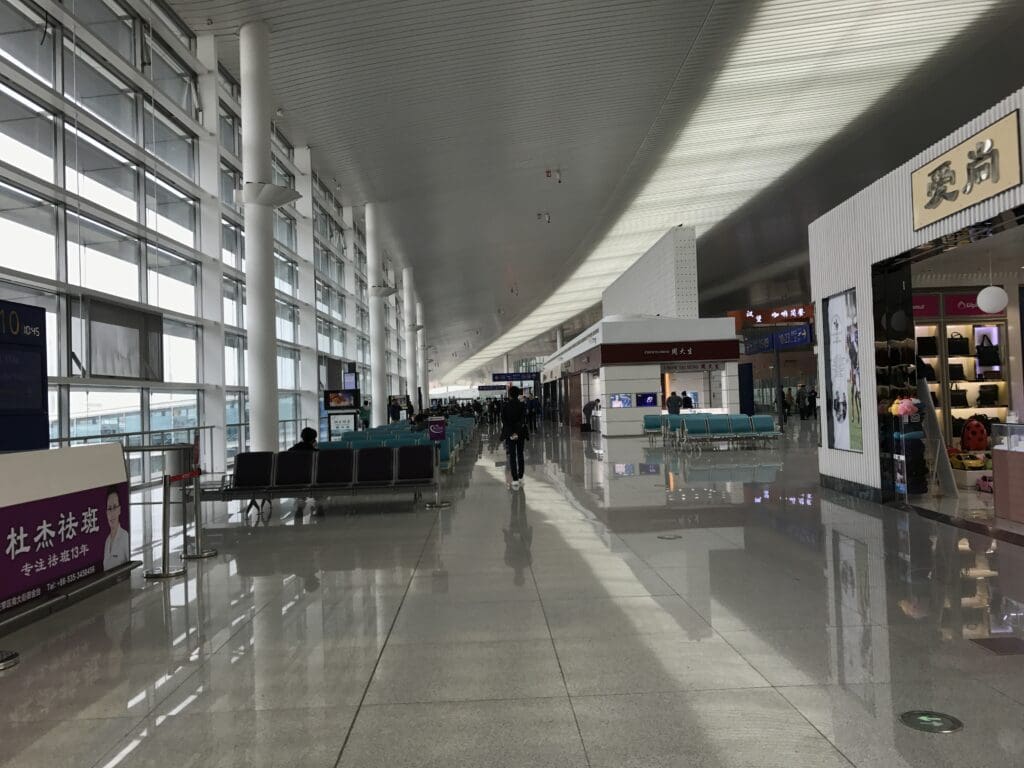
With little to do, I took a seat and watched the movements on the apron outside. Enjoying the status of China’s fortieth busiest airport (as of 2017), it is fair to conclude that Yantai Penglai lacks the never ending stream of movements that can be seen at the likes of Beijing Capital, Guangzhou or Shanghai Pudong. However, I was still able to spot a good variety of airlines and aircraft types. Prior to the arrival of the inbound Xian MA60, the highlight movement came in the form of a Tianjin Airlines Embraer 145. Whilst this small jet is common at airports across the world, it was still a little strange to see one of these little jets in a country where Airbus A320 Family and Boeing 737NGs dominate domestic routes! Turning to the other movements, surprisingly given the airline’s major presence at Yantai, the ramp was devoid of any Shandong Airlines aircraft. Instead, my stay fell within the morning rush of Air China flights, with the airline operating three Airbus A320 services to Beijing, Chengdu and Daqing. Meanwhile several China Eastern Airlines Airbus A320s and a Shanghai Airlines Boeing 737-800 could be seen waiting for their next missions.
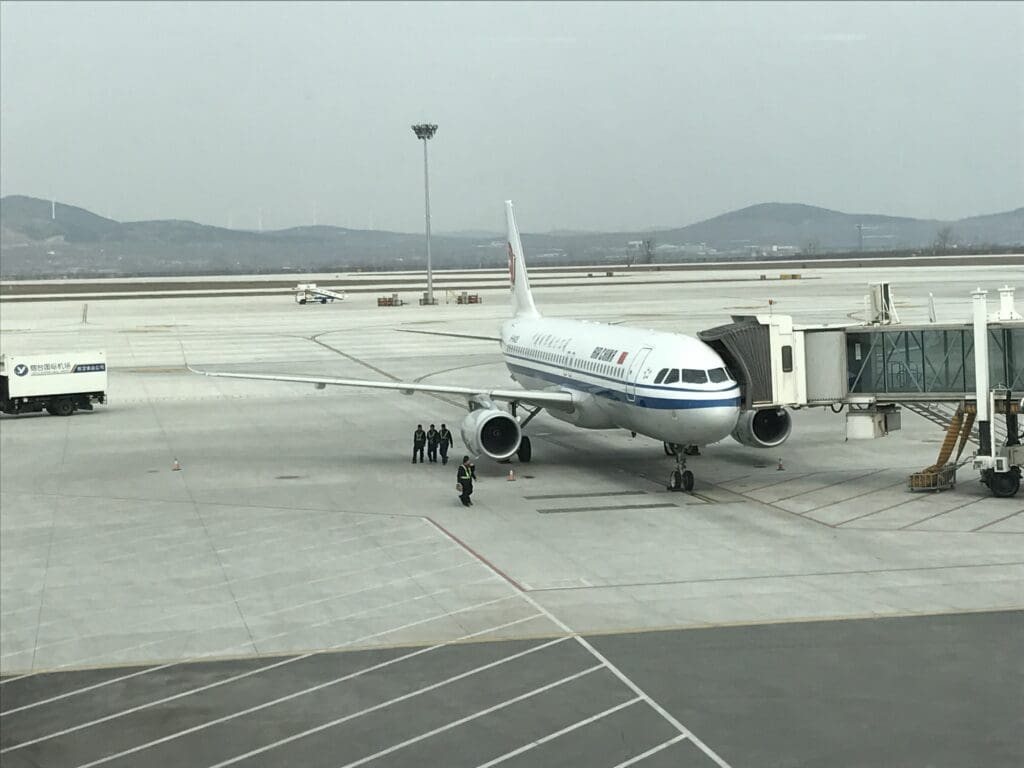
At 1045, I watched as the somewhat weathered looking Xian MA60 came floating down through the chilly Chinese skies before returning to earth with a puff of white tyre smoke. Expecting this turboprop to adorn the standard blue and white livery of Joy Air, instead, this came in the orange and white colour scheme of Okay Airways. This was explained by the fact that this particular aircraft was one of those that had previously operated by this low cost carrier and had been handed over to Joy Air in October 2016 when the airline decided to focus exclusively exclusively on Boeing 737 operations. This particular example came in the form of B-3712 and carried the construction number of 913. Manufactured at some point in 2012, this aircraft was around five years old at the time of my flight. Soon, the aircraft came to a halt at a remote stand at which point I decided to head down to the bus boarding gates.
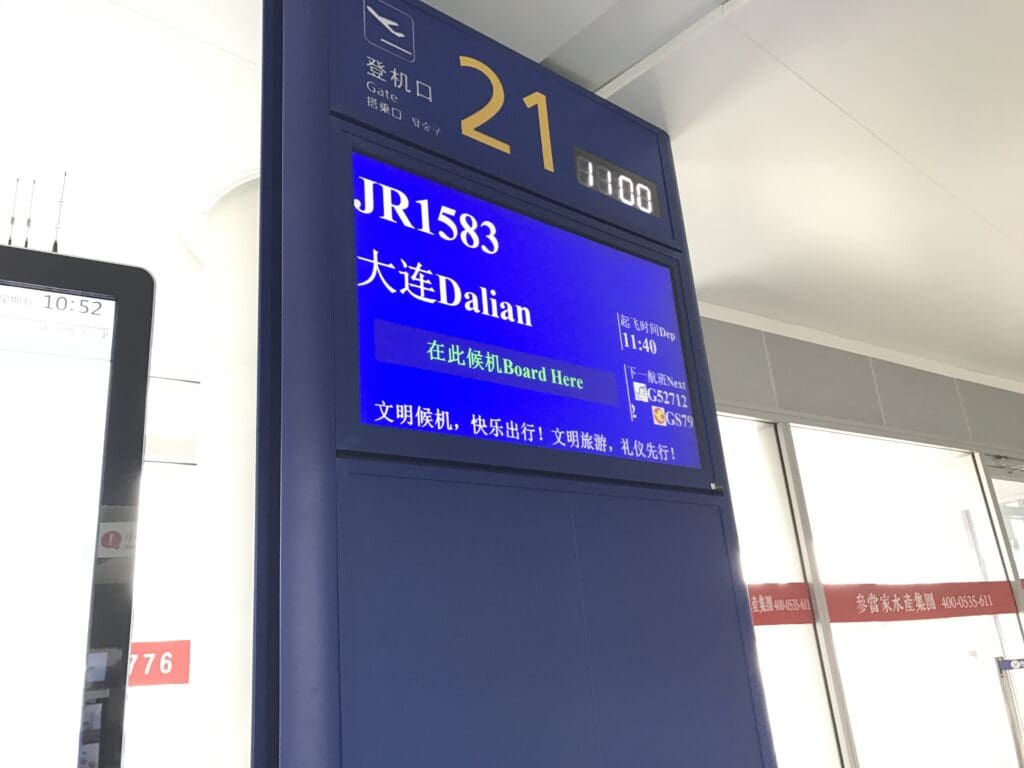
Requiring a short bus ride to the aircraft, boarding was scheduled to commence thirty minutes before departure at 1110 and by the time I made it to Gate 21, a grand total of twenty passengers could be seen waiting around this. Whilst I was sceptical that, even with a bus ride, boarding would take a full thirty minutes, a few minutes ahead of the scheduled boarding time an army of ground staff appeared and at 1110 on the dot, an announcement was made in Mandarin and English requesting Dalian bound passengers to board. Soon, I handed over my boarding pass which was scanned before I was able to board the waiting bus. That morning, all passengers were to be squeezed onto a single bus and thus a short wait whilst the last stragglers arrived.
At 1125, with a grand total of 33 passengers onboard, the bus doors slid closed and the bus slowly pulled away from the terminal building. Looking around, unsurprisingly most passengers on the flight to Dalian hailed from China. However, I did also spot two passengers each from Korea and Russia. Despite being a Saturday, it seemed that a fair number of passengers took the form of business travellers, dressed smartly in suits. Either that, or they liked to keep things formal! As we made our way out across the apron, the bus came to a temporary pause in order to allow for a China Eastern Airlines Airbus A320 to pull into a gate before we arrived at ultra-rare Xian MA60 that would be carrying us all across the Bohai Strait that morning.
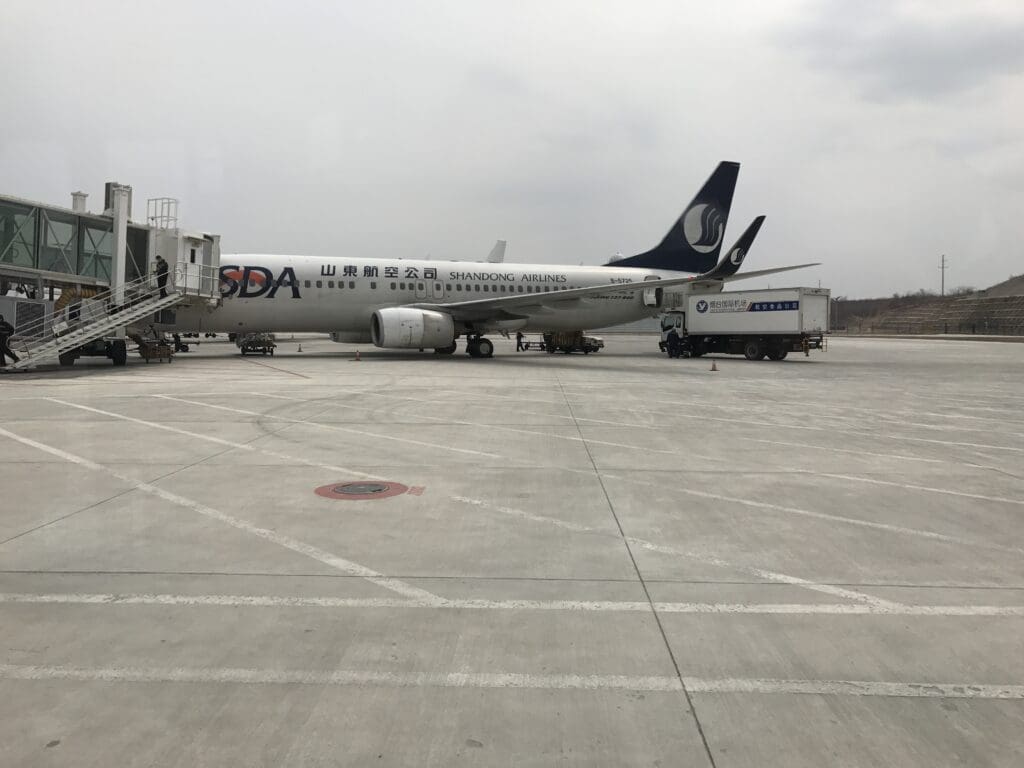

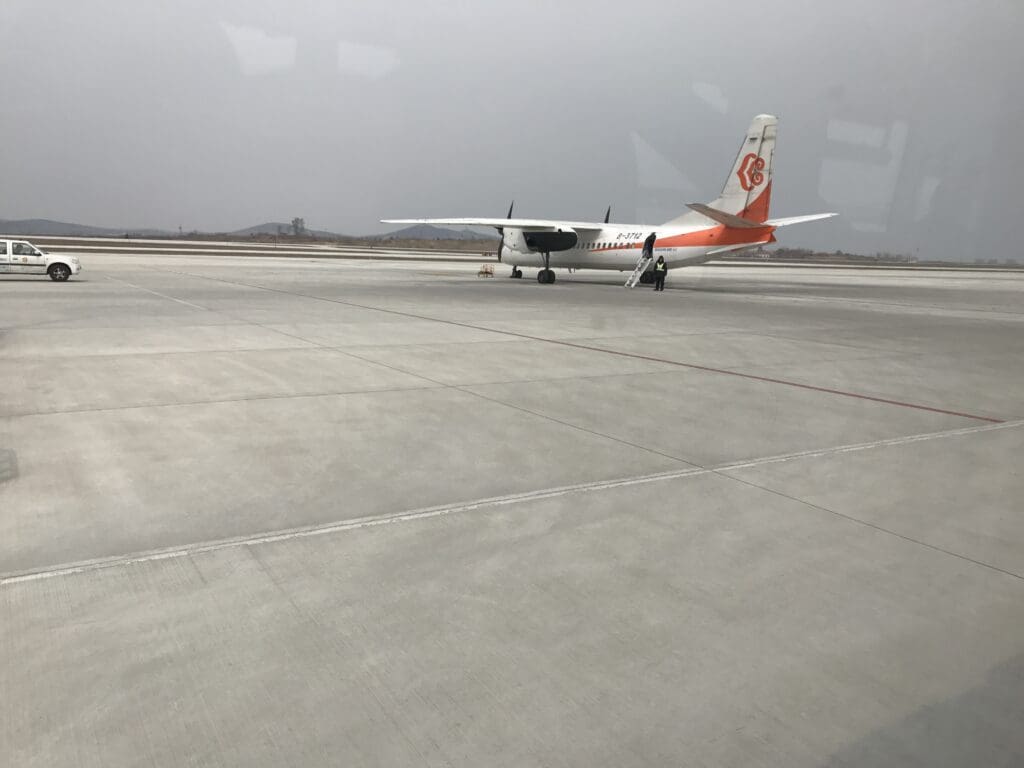
As soon as the bus pulled up to the rear of the aircraft, the doors slid open and a queue formed leading up to the only cabin door. Like the aircraft’s Chinese and Soviet predecessors, the Xian Y-7 and Antonov An-24, alongside the ATR family, passengers must board the aircraft via a door at the rear of the rear of the aircraft. Following a short wait, I made my way up the ladder before ducking down so as to avoid ending up with a head injury as I entered the aircraft. Once inside, I found myself in the very spacious galley and luggage hold area at the rear of the aircraft and almost immediately received a subdued greeting in Mandarin from the sole flight attendant onboard. Given the short length of the flight, there would be no inflight service, although 500ml bottles of still spring water had been placed on the rear jumpseat for passengers to take before entering the cabin.
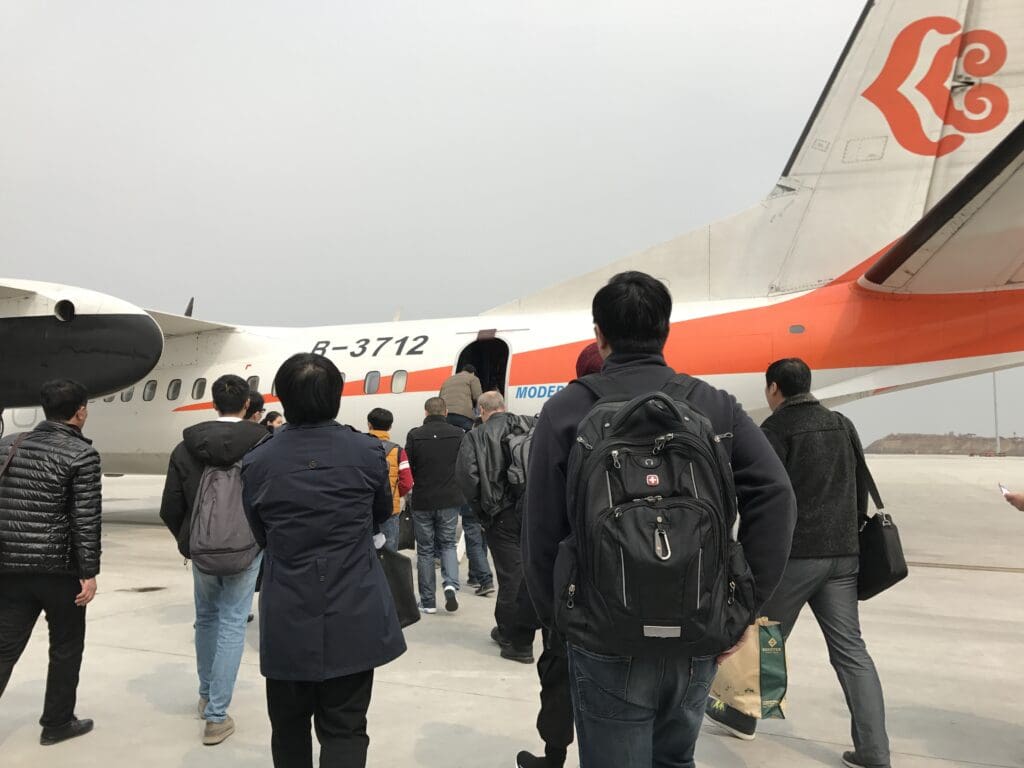

Within a matter of seconds, I entered the Xian MA60’s relatively small passenger cabin. Seeing as passengers can only board and disembark via the rear of the aircraft, the aircraft’s small business class section can be found at the very rear of the passenger cabin. This consisted of a single row of very comfortable looking seats in a 1-1 configuration, each complete with a large bright orange pillow. Curiously, these bore an uncanny resemblance to the seats that were once installed onboard Air France’s Concorde seat! Following another short wait whilst those in front of me attempted to squeeze their backpacks into the small overhead lockers, I entered Economy and made my way up the narrow aisle before arriving at the fourth row.
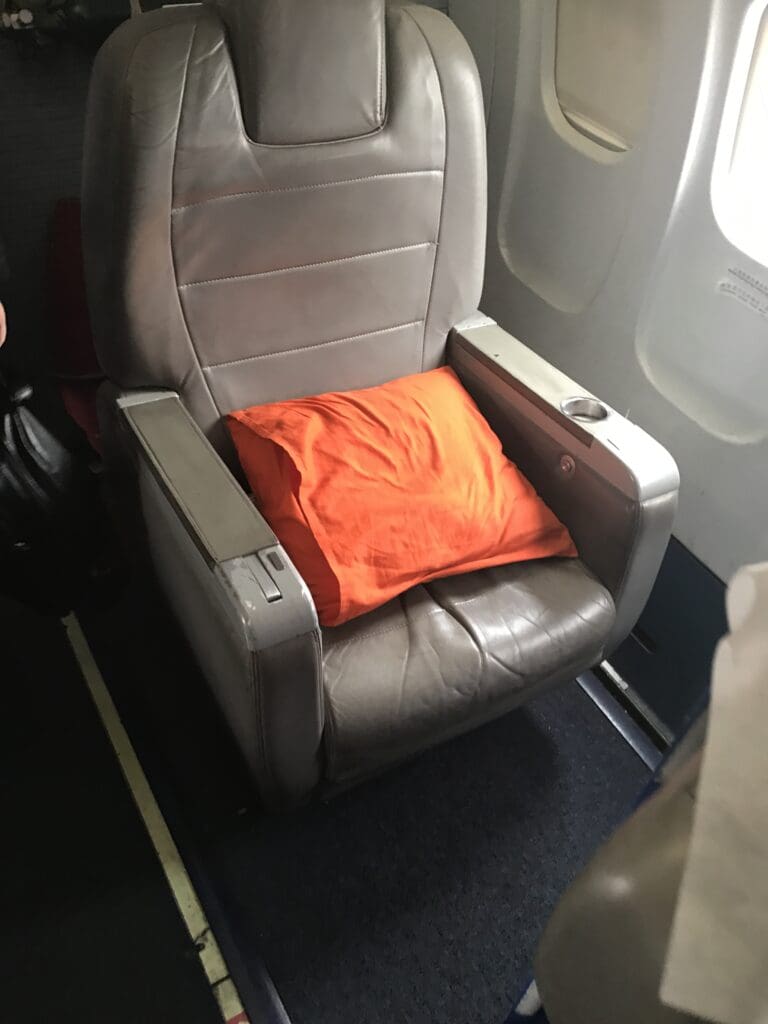
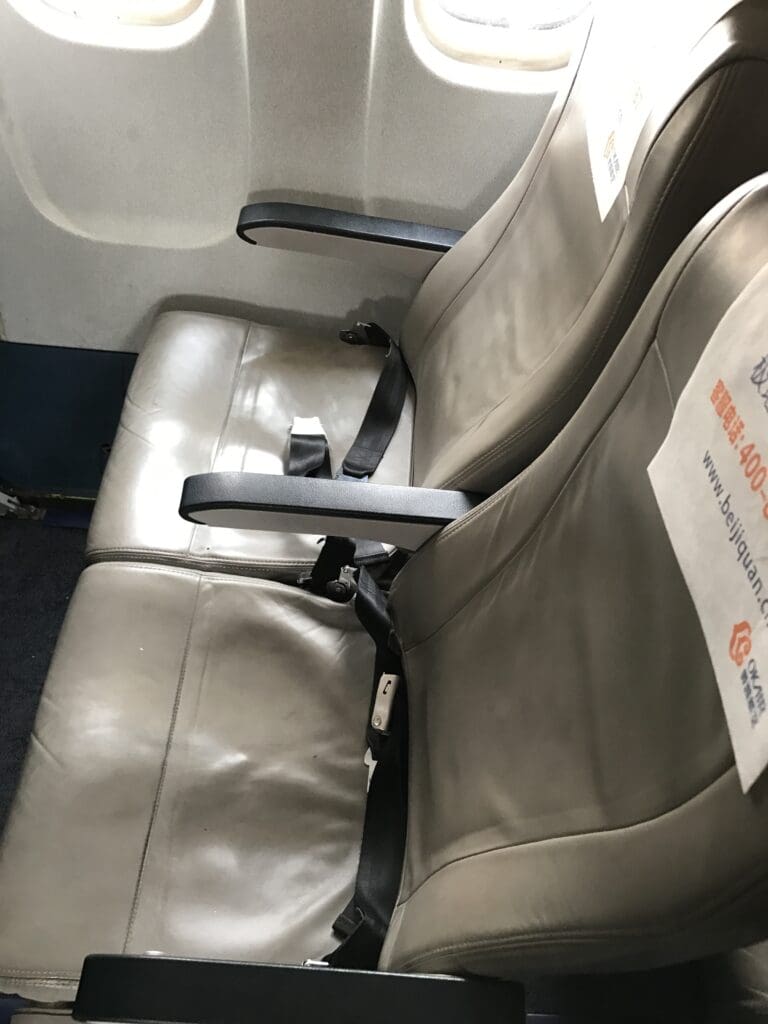
In Economy, each seat appeared to be rather thin and was covered in a beige pleather cover. Whilst not appearing to give off an overly uncomfortable aura, once seated, a combination of the rock hard seat and the rather terrible legroom made me thankful that I would only be trapped in this for a fairly short time. Worsening the aircraft’s identity crisis, each seat featured a disposable antimacassar that featured Okay Airways’ logo alongside an advertisement for Arctic Spring, a brand of bottled water. Turning to the seatback pockets, these contained a Joy Air branded safety card and a compact guide for Mount Huangshan, located a long way away from Yantai in China’s Anhui Province. Looking around, the cabin appeared to be rather modern and comparable to say that of a new ATR or a Dash 8 Q400. However, the aircraft appeared to be battered and worn beyond its years, with plenty of marks, scratches and other blemishes seen all over. Despite this, I am pleased to report that the cabin was clean and tidy.

Once I had settled in for the short ride, I was joined by a seatmate and in what seemed like no time at all, boarding reached its end. At this time, the stern looking security guard who had stood guarding the door to the forward cargo hold and cockpit for the duration of boarding retired to their seat in the front row of the aircraft.
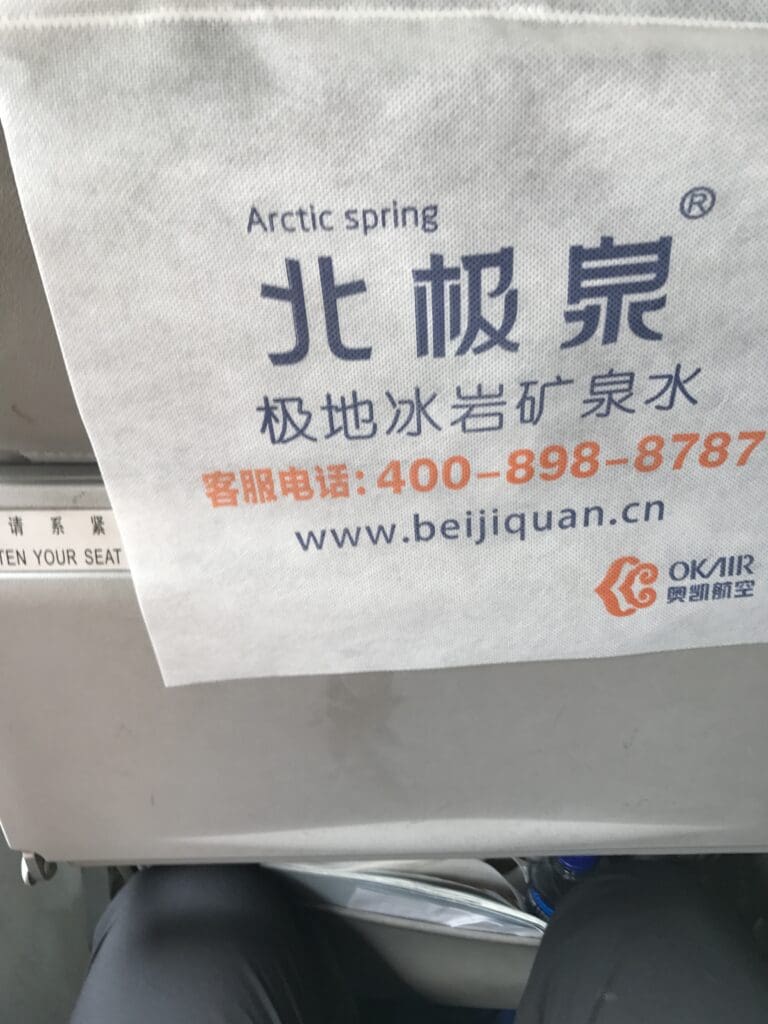
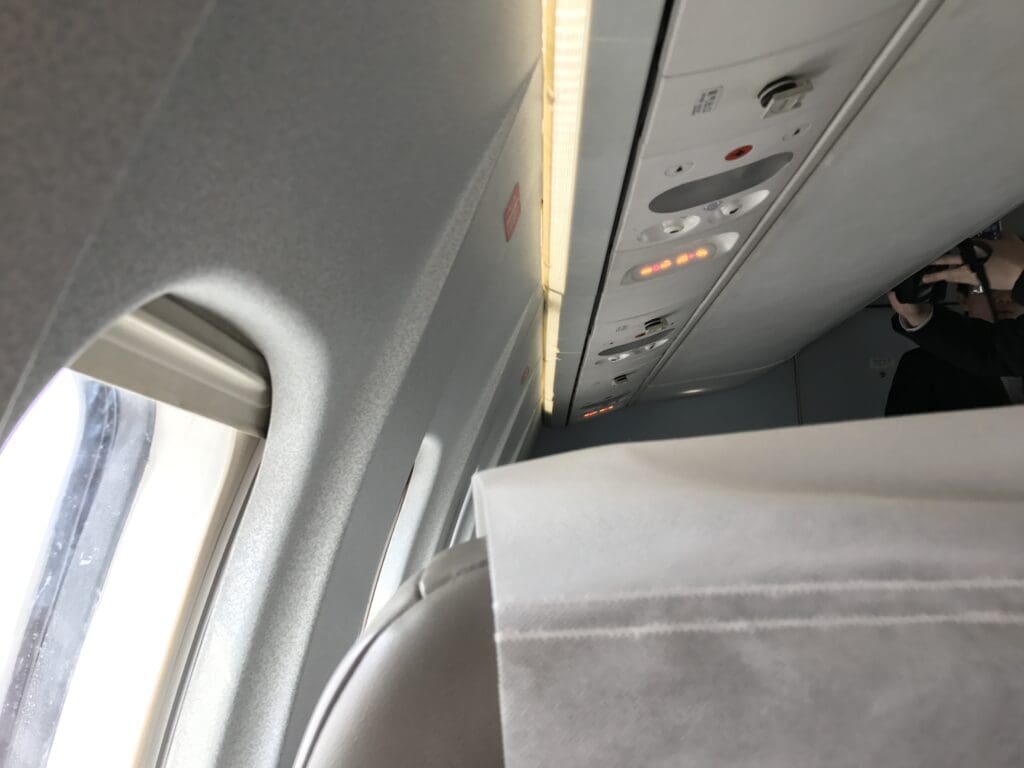
As soon as boarding was over, the door at the rear of the cabin was shut and in almost no time, the aircraft’s propellers began to whirl before the two Pratt & Whitney PW127J engines began to fire into life creating plenty of noise in the process. As the two engines powered up, the flight attendant performed a short and barely audible announcement in Mandarin only before making their way through the cabin to ensure that all was secure and in place for our departure. Adding to the confusion regarding the aircraft, the flight attendant seemed to be donned in a uniform that whilst smart, was neither that of Joy Air nor Okay Airways! This welcome announcement was followed by a short pre-recorded safety announcement in Mandarin and English. Without delay, the MA60 lurched forwards out of its stand and we commenced our journey to the end of Runway 04. From our stand, nothing more than a very short taxi was in order before we arrived at the end of the runway. Once there, the aircraft was required to hold for a China Eastern Airlines Airbus A320 to touch down at the end of its journey from Seoul Incheon Airport.
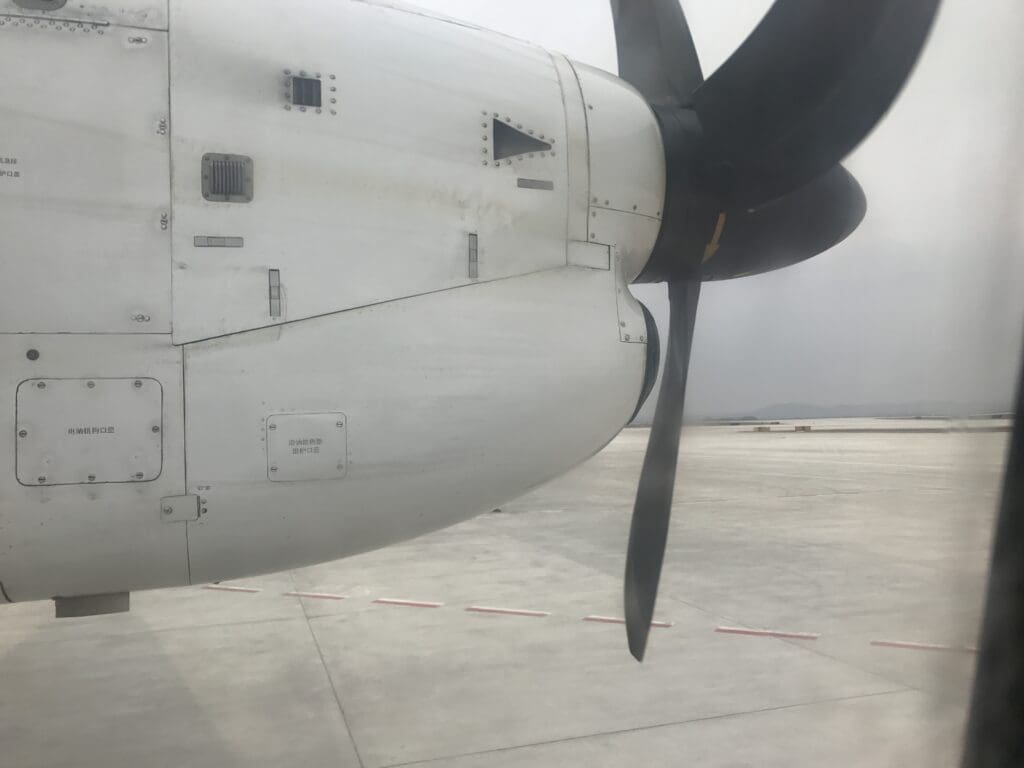
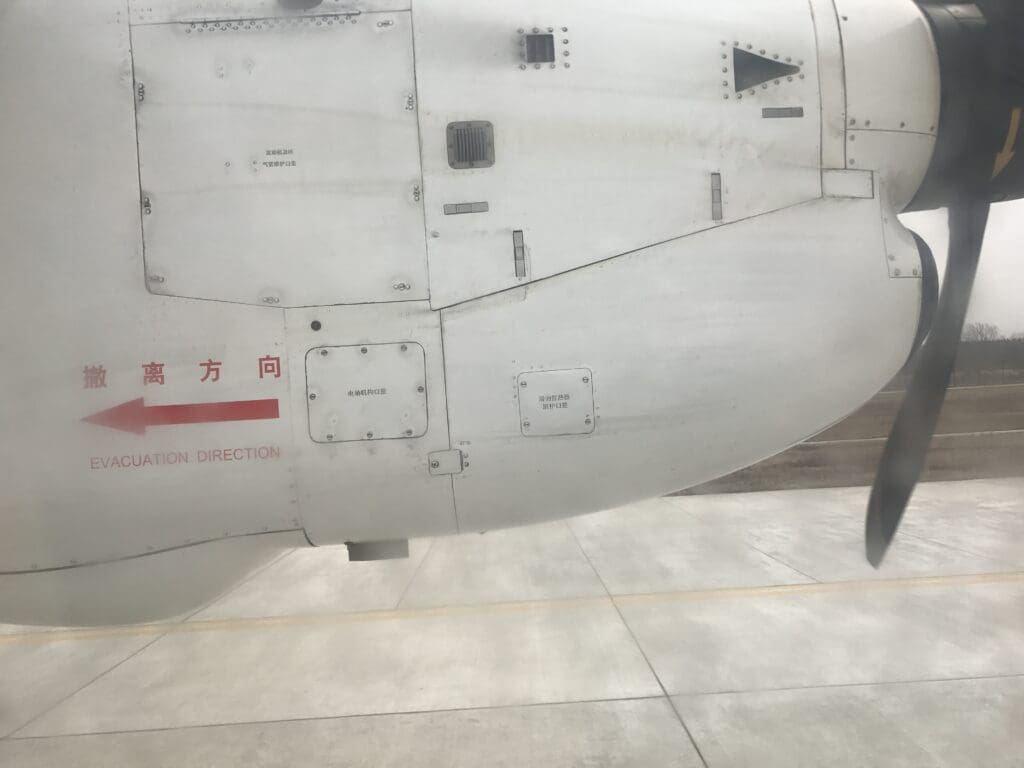
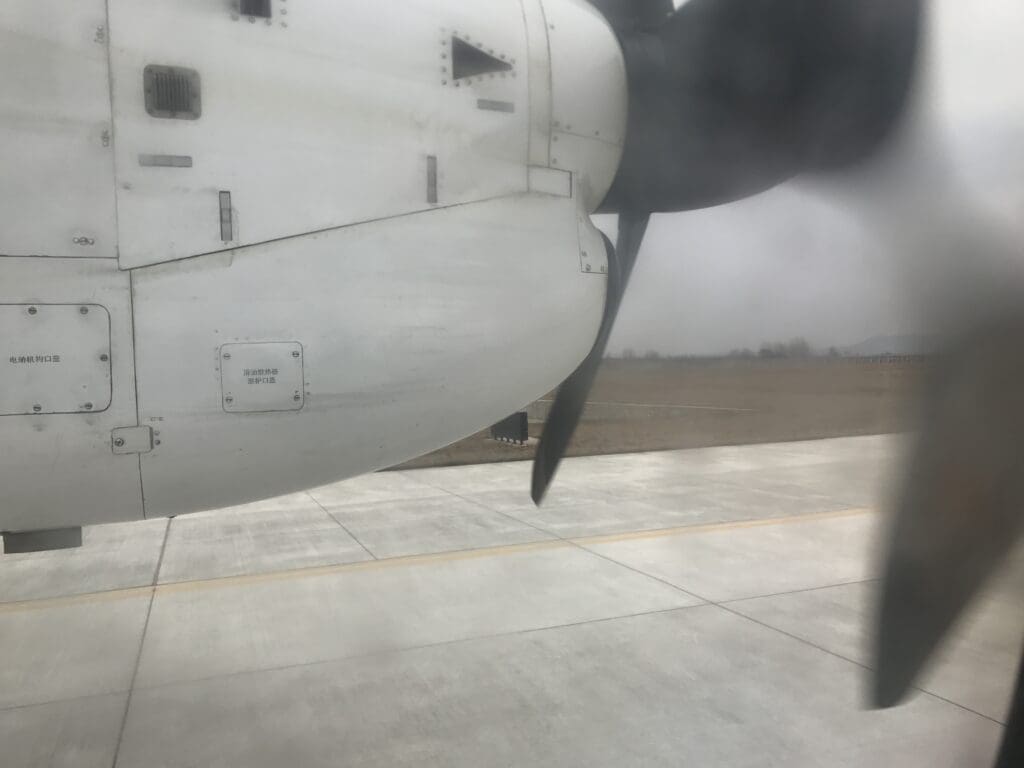
At 1115, the MA60 rumbled onto the runway and paused for a few moments as the Airbus vacated this some distance ahead. Soon, the cabin was filled with noise and intense vibrations causing the seats to turn into massage chairs as we rocketed down the runway. Several months later, I would be lucky enough to end up flying the Antonov An-24 in Kazakhstan and I can safely say that the level of noise and vibration during our take-off seemed to be of a very similar to level to that provided by the two Ivchenko engines of this venerable Soviet type. In what seemed like no time, the Xian MA60 took to the skies and we began what seemed like a very steep climb, soon leaving the airport behind before crossing out over the industrial estates that line the coastline to the north of the airport and soaring over the blue waters of the Bohai Strait.
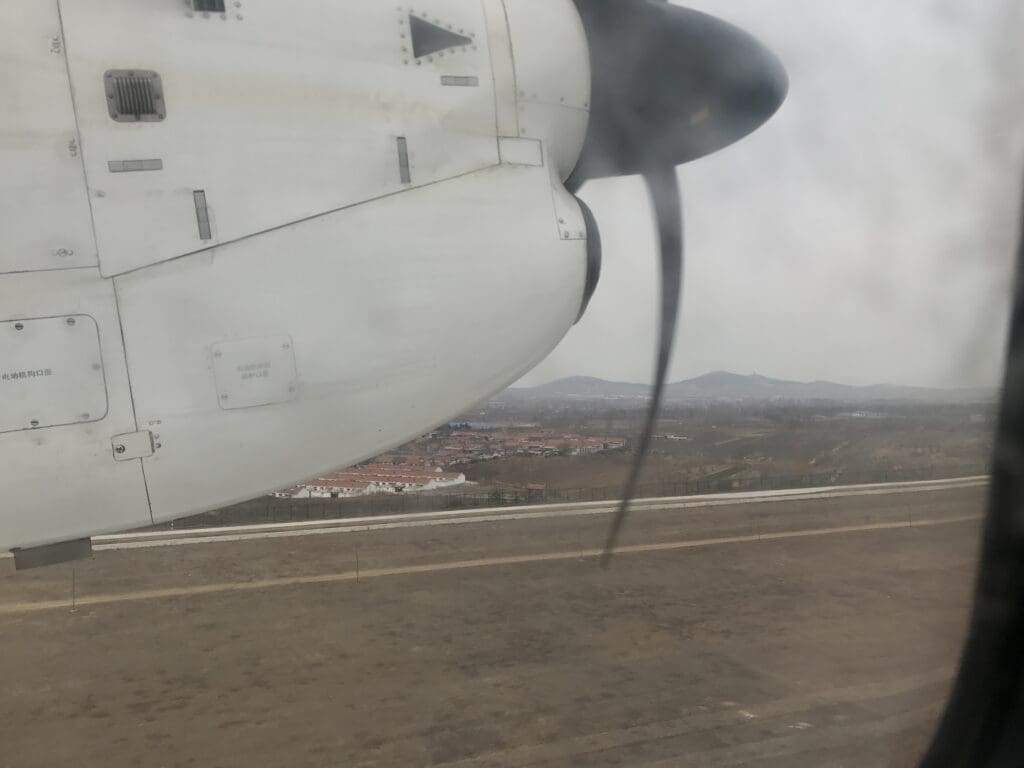
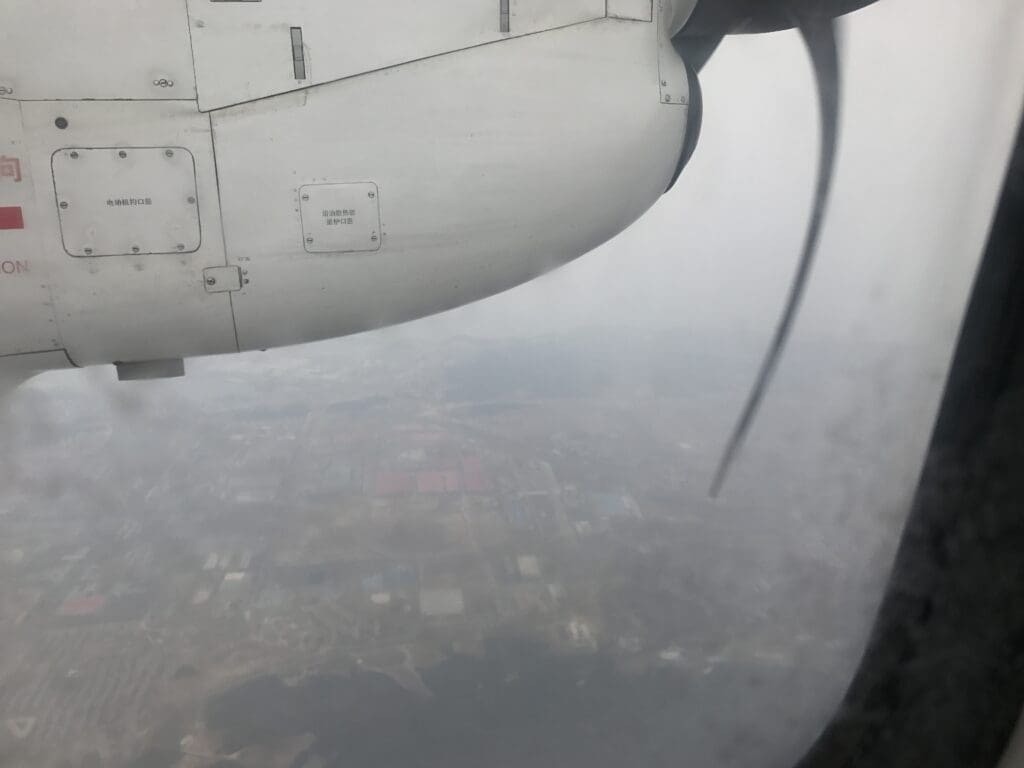
Ignoring the noise, vibration and the steep climb, our journey up to our cruising altitude was a straightforward affair with virtually no turbulence. Soon, the engines quietened down and we levelled off at our cruising altitude. Inside the cabin, the seatbelt signs remained firmly illuminated, although as I don’t think that I have ever taken a flight with a Chinese carrier whereby these are actually extinguished and instead serve as more of a reminder to passengers that they ought to remain seated with their seatbelt fastened. One person that wasn’t obeying these signs was the First Officer, who soon emerged from the door at the front of the cabin and made their way to the rear of the aircraft, presumably for a comfort break.
Thanks to the clouds that lingered over the Bohai Strait, passengers were not treated to views of the many ships that plough through these waters until we neared Dalian. Inside the cabin, whilst the level of noise had decreased, once we had levelled off, high levels of vibration remained a constant feature until we had returned to Earth. With no onboard service, for the duration of the cruise, the flight attendant remained buckled up in their jumpseat, although this is by no means a complaint given the short length of the flight.
Only minutes after reaching our cruising altitude the aircraft could be felt commencing its descent, and a few minutes later, the flight attendant performed an announcement in Mandarin only which I assume went through the usual pre-arrival warnings before passing through the cabin ensuring that all was secure and in place for our arrival. Descending through the clouds with a few bumps, once through these, the blue Yellow Sea could be seen below through the scratched window, soon followed by the coastline of Liaoning Province.
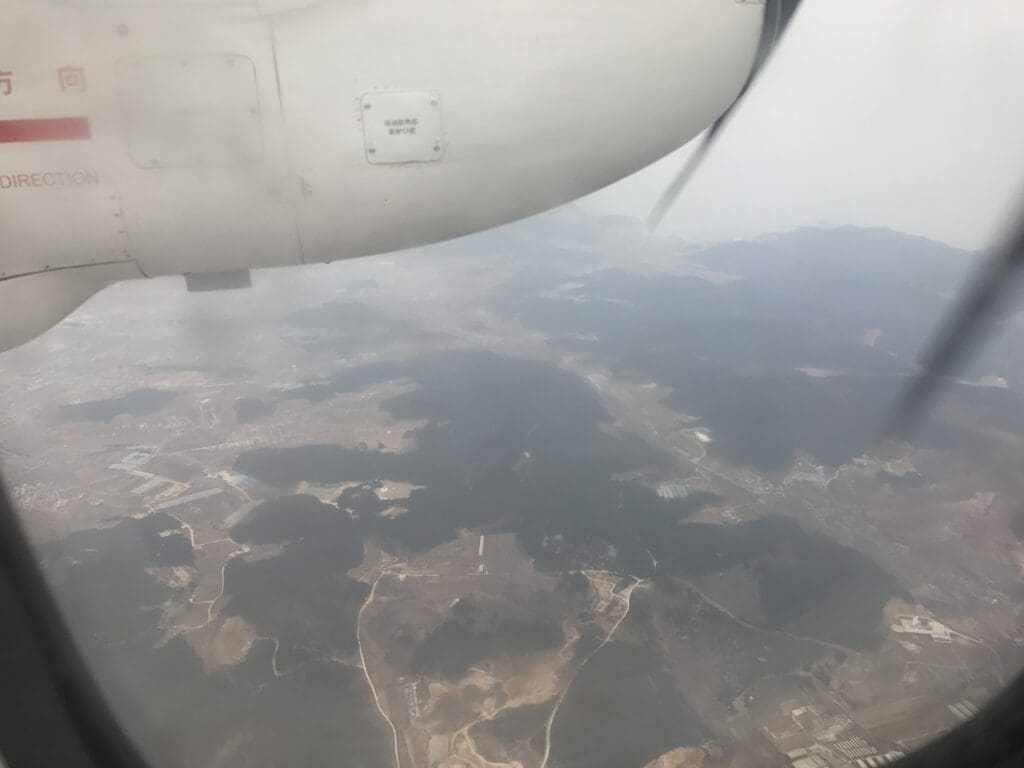
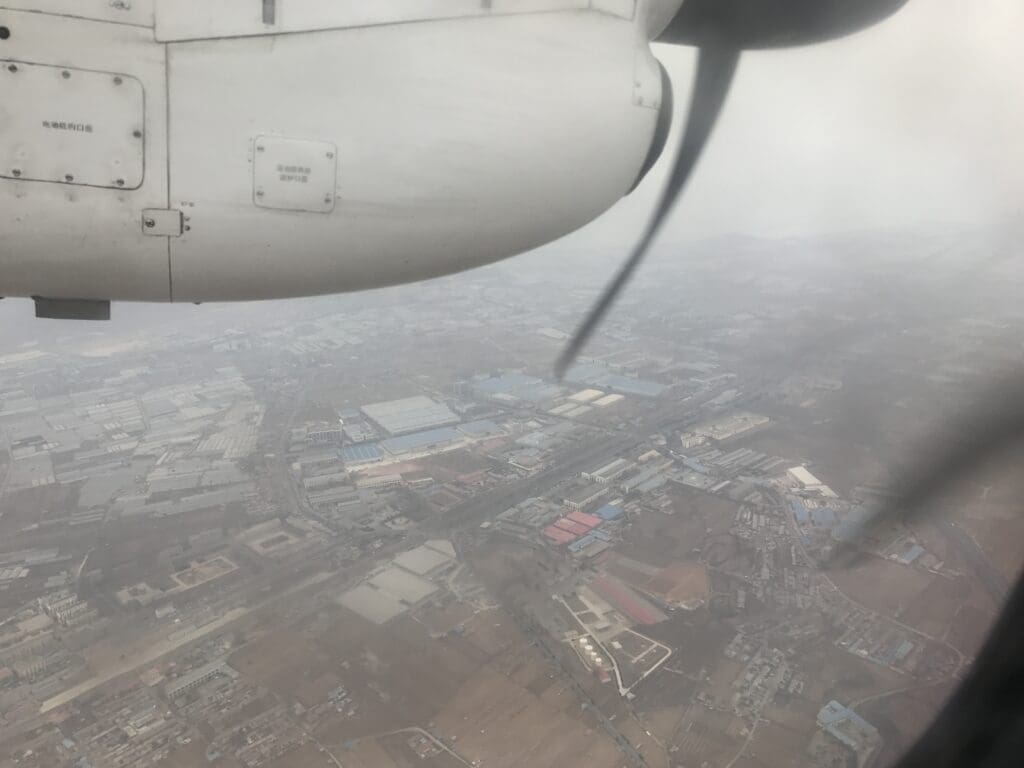
Continuing onwards, after making a few turns, the aircraft seemed to establish itself on the approach to Dalian Airport’s Runway 10. As we crossed the shoreline, a plethora of industrial areas popped up out of nowhere before suddenly transforming to rows and rows of fancy looking apartment blocks and large villas as we neared the airport. Soon, a loud clunk could be heard and the aircraft could be felt decelerating as the flaps and landing gear dropped down into position in preparation for our arrival into Dalian. From there, the aircraft seemed to make a relatively steep dive down to the runway and below we soon passed over the airport’s well-guarded perimeter fence.
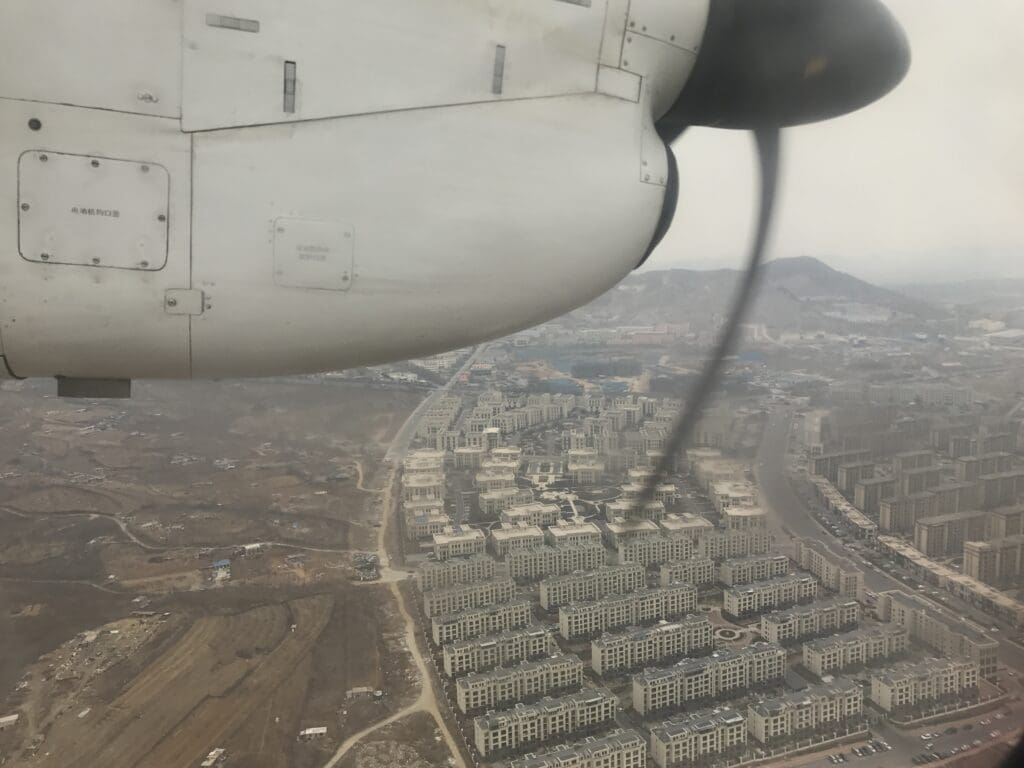
Following a mere 33 minutes in the Chinese skies, the Xian MA60 touched down in Dalian with a significant thump. This was followed by some rather gentle braking before we vacated the runway and began the short journey to a remote stand. Once safely on the ground, there was no sort of post-arrival announcement from the flight attendant and instead music rang out thorugh the cabin as we made our way to the stand. Looking outside, lunchtime appeared to be rush hour at Dalian Airport, especially amongst flights from Japan and I soon spotted a Japan Airlines Boeing 787-8 Dreamliner that had arrived from Tokyo Narita, along with an ANA Boeing 737-800 and a Boeing 787-8 Dreamliner from Osaka Kansai and Tokyo Narita respectively. As expected, the usual interesting smorgasbord of Chinese airlines could be seen, alongside a good number of Boeing 737-800 operated by hometown airline, Dalian Airlines.
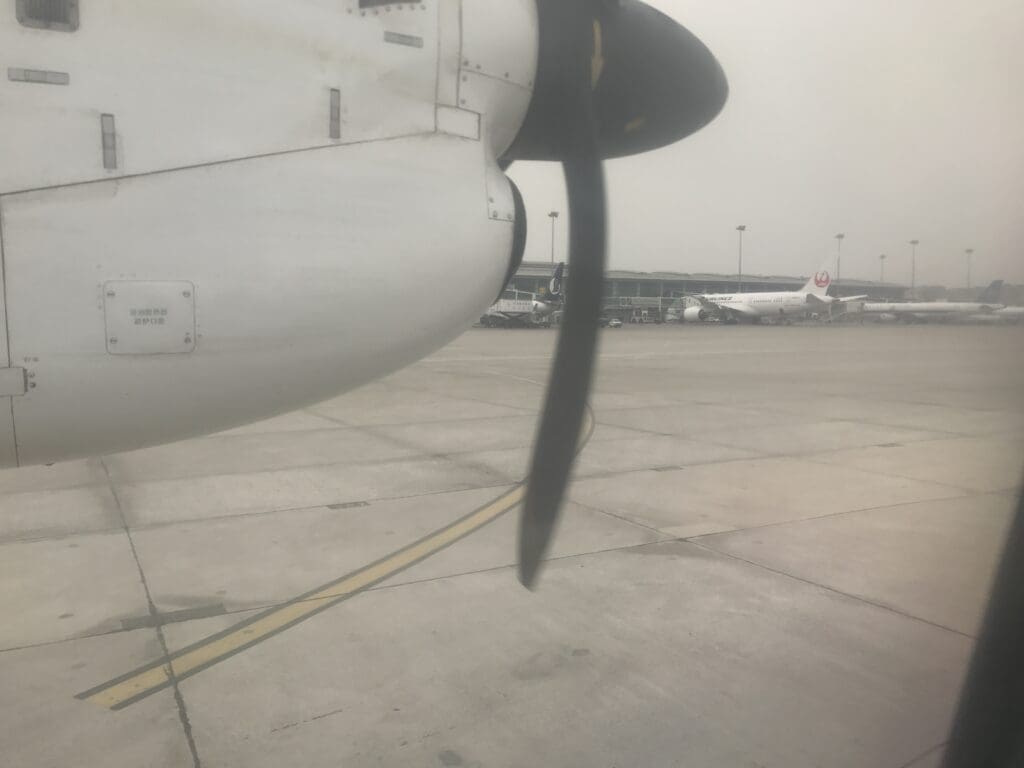
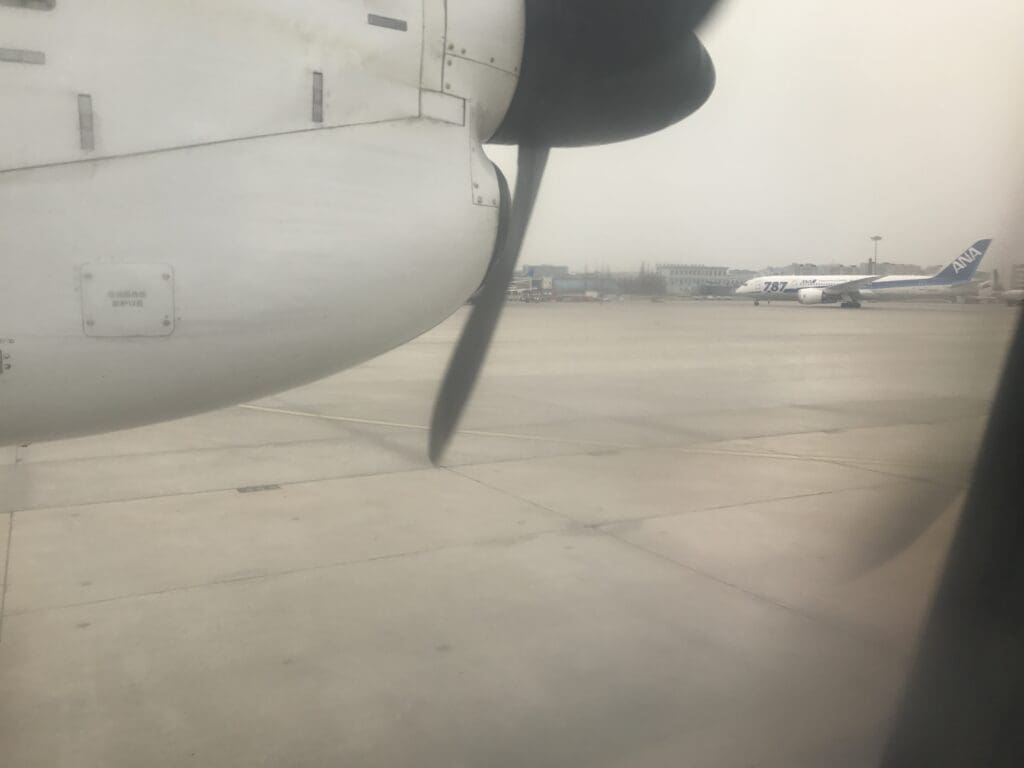
Around fifty minutes after our engines had powered into life, the MA60 came to a halt at a remote stand and the vibrations and noise came to an end and passengers sprung up. Within moments, the cabin door was opened and, seemingly desperate to escape from the uncomfortable aircraft, almost immediately passengers piled and boarded the waiting bus. In no rush to leave, as the final passengers disembarked, I stood up and made my way through the now somewhat messy cabin before boarding the bus. A short time later, the bus pulled away from the aircraft and made its way towards the terminal where it arrived no more than a couple of minutes later. As seemed to be the case with most passengers, I did not have any luggage and thus upon arriving at the terminal, I found myself surrounded by drivers touting for custom in the landside arrivals area. Thankfully, Dalian Airport is connected to the city’s subway network and so reaching the city centre was neither a difficult nor costly task and most certainly did not require an expensive taxi ride.
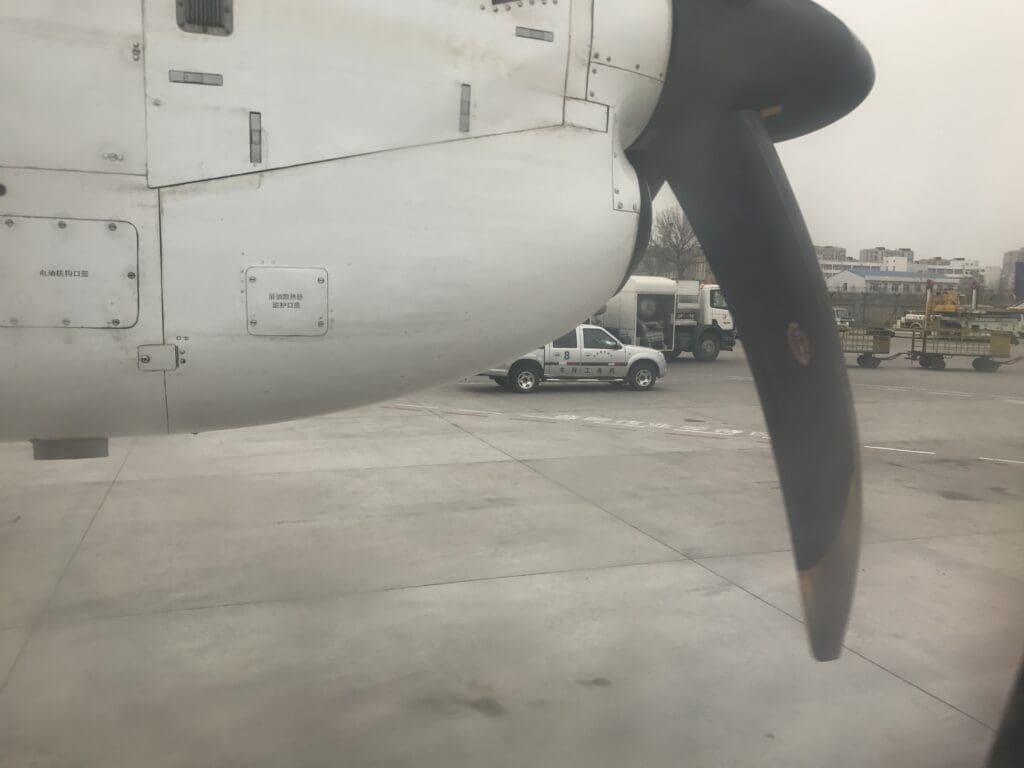
Despite having a single afternoon in Dalian, I was able to see a selection of sites located within the city, paying a visit to the interesting Dalian Modern Museum, strolling along Russian street and nearly being attacked by a flock of aggressive seagulls in Xinghai Square – the largest square in the world. Admittedly, whilst the sole purpose of my trip to Dalian had simply been to catch a ride on the Xian MA60, the city was pleasant enough with a reasonable number of sights and things to do to keep me occupied. After several hours, I decided to retire to my hotel, the Dalian Airport branch of the Green Tree Inn – a Chinese chain of budget hotels, reaching the hotel by catching the subway back to the airport before making a short walk to the hotel.
Dalian to Yantai
Despite being decidedly shabby and in need of refurbishment, I found the Green Tree Inn to be pleasant enought and given the cheap price that I had paid for a night there and its proximity to the airport, I could find little reason to make a valid complaint. Having had a packed Saturday, when night fell I slept like a log and awoke at the early hour of 0600, ready and raring to fly back southwards to Yantai. Following an incredibly heartburn inducing breakfast of oily ramen, and once I had washed, showered and readied myself for the day ahead, I headed down to reception, handed over my key and began the short walk along the busy main road to the airport. Fortunately, that morning, the air seemed to be notably less polluted and thus the walk to the airport proved to be much more pleasant than the walk over to the hotel the previous day. Either that, or I had already become acclimatised to the Dalian air. Fifteen minutes after leaving the hotel, I arrived at the terminal with a little under three hours to go until my flight to Yantai was scheduled to depart.
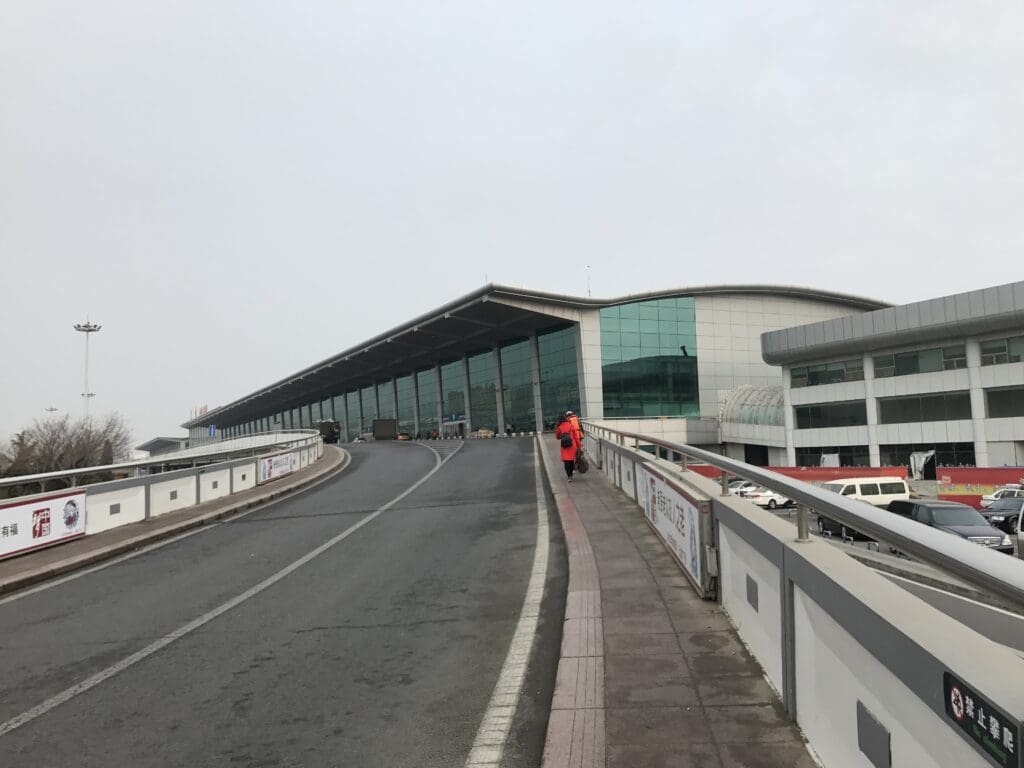
Looking around, it was evident that the architect behind Dalian Airport was probably a graduate of the School of Chinese Airport Design. This was very similar in design and layout to that of many regional airports across the length and breadth of China. Namely, this consists of a large glass and metal covered terminal, and once inside I found myself in the terminal’s large and spacious check-in hall. Although despite this, I should mention that the strange lack of lighting made this appear to be comparatively dark and dingy. Aside from this complaint, I found the terminal to be relatively modern and clean, with the exception of all toilets that I visited during my stay which were in an atrocious state! With Dalian Airport being a significant hub for China Southern Airlines, explained by the giant’s absorption of China Northern Airlines back in 2004, around half of the check-in desks were reserved for the exclusive use of those departing on China’s largest airline. In addition to this, like many airports in China, the check-in hall also feature a private ‘VIP’ check-in area for those departing in a premium cabin.
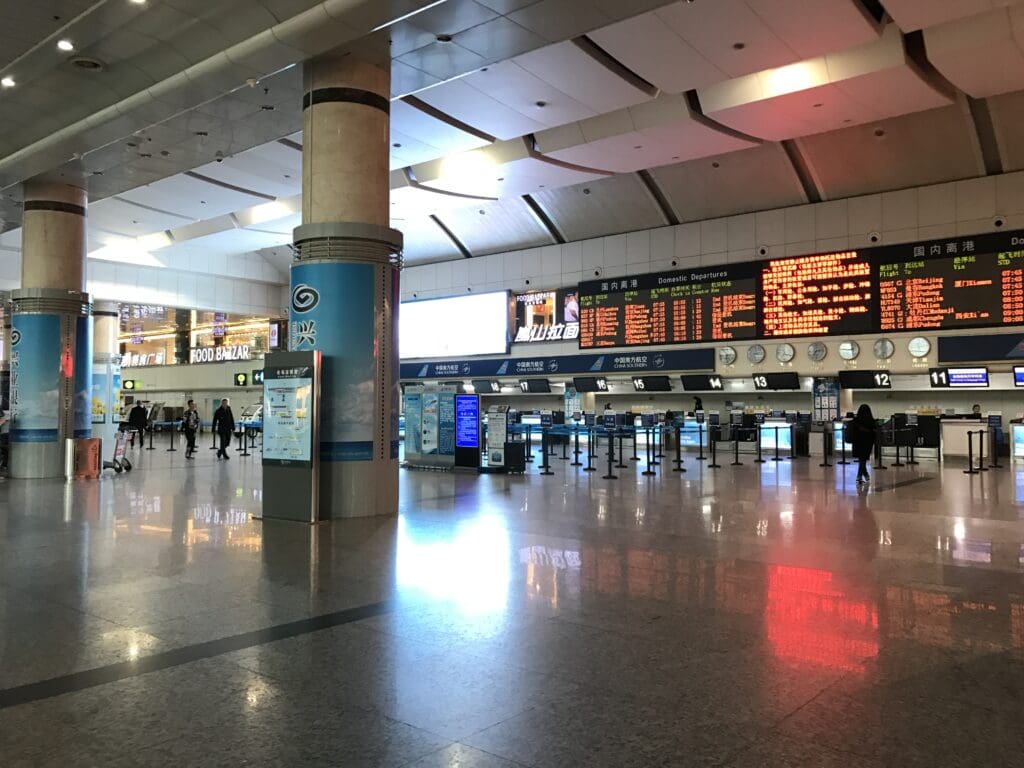
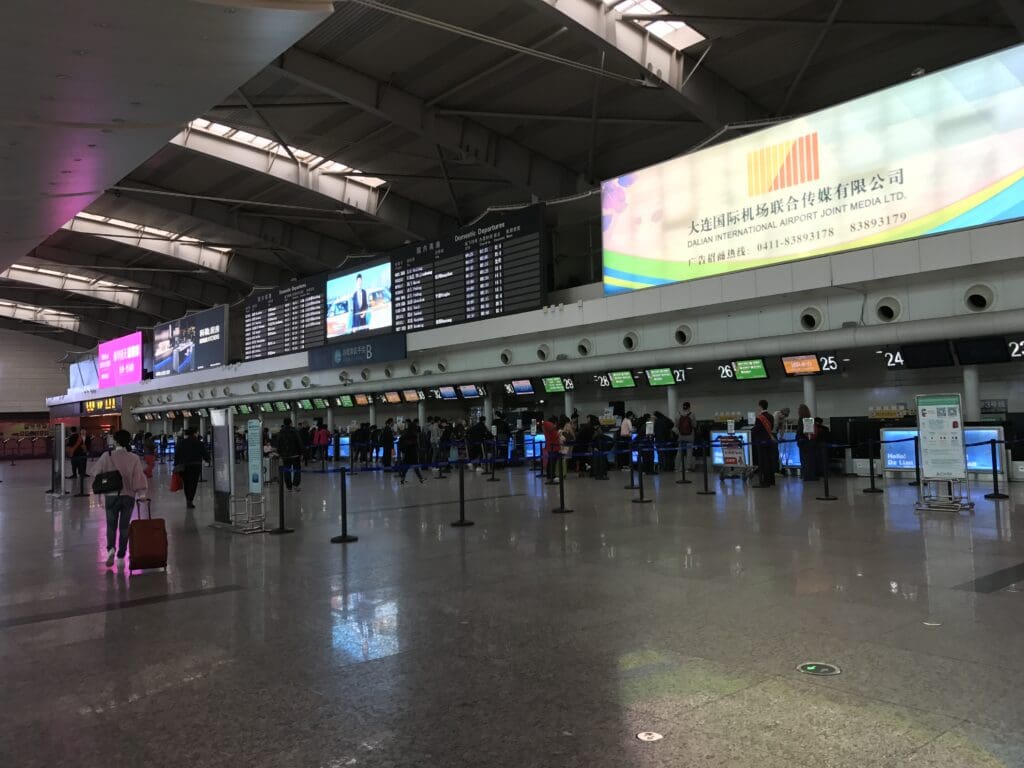
Despite there being a near-endless stream of flights departing to all corners of China that morning, contrasting with my experience in Yantai the previous day, I found the check-in area to be surprisingly calm and quiet. Much to my delight, I was able to walk straight up to a desk without any waiting where I was given a polite greeting in Mandarin by one of the airport staff members. Following a brief interaction in which I requested a window seat, once the agent had examined my passport and furiously typed away, a Dalian Airport branded boarding pass was printed off which revealed that I had been assigned Seat 12D, a window seat in the rearmost row of the Xian MA60’s Economy cabin. With this in hand, considering the lack of airside views in the landside portion of the terminal, I saw little reason to remain there and I thus continued onwards to the security checkpoints. Once again, this was pleasantly quiet and following the usual comprehensive check of my passport, my boarding pass was stamped and I was free to make my way to one of the checkpoints. As is usually the case in China, I found the security check to be comprehensive, with no proverbial stone left unturned, however, having correctly decanted my items, there was no need for any additional checks and I made it airside no more than five minutes after arriving at check-in.
Unsurprisingly I found the airside area to be a little busier, although most people seemed to be waiting in the main waiting area at the centre of the terminal and as I ventured further away from this, I encountered fewer passengers. Wanting a peaceful morning, I thus decided to head to the far end of the terminal where I took a seat next to one of the windows and decided to partake in some morning spotting. Being a fairly major airport, I found the terminal to contain a fair selection of shops and eateries. For those not willing to try the local delicacies, Western options come in the form of McDonalds and Starbucks. Unfortunately, yet as is usually the case at Chinese regional airports, I found that the terminal’s complimentary wifi network could not be used by those who lack a Chinese phone number.
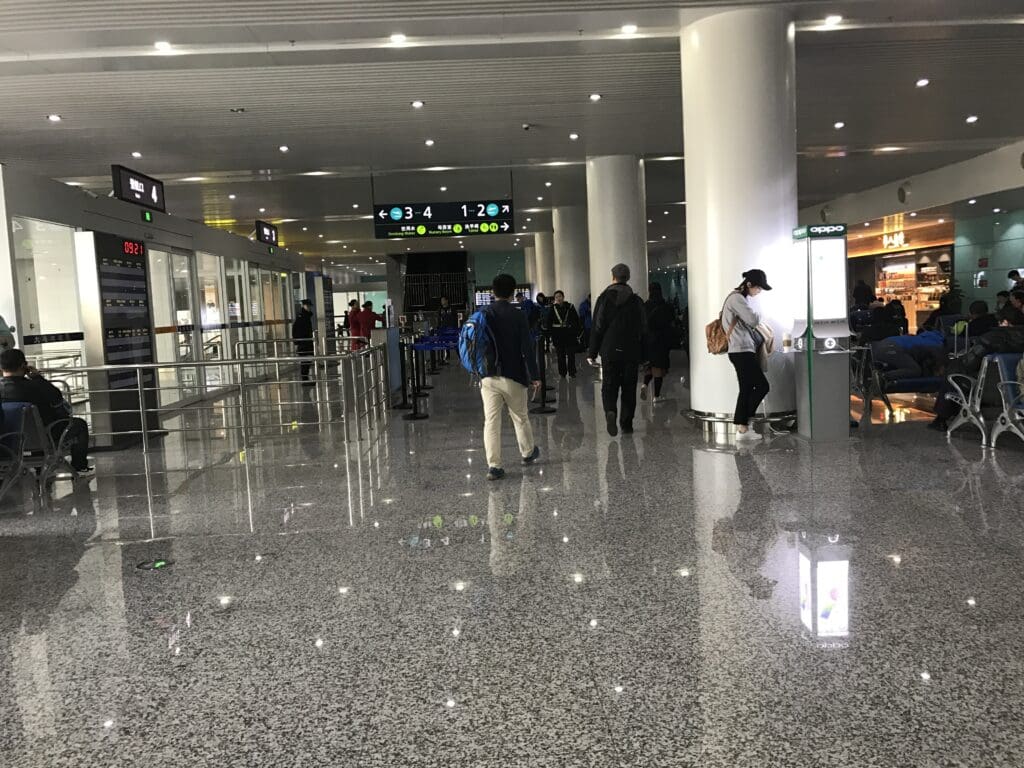
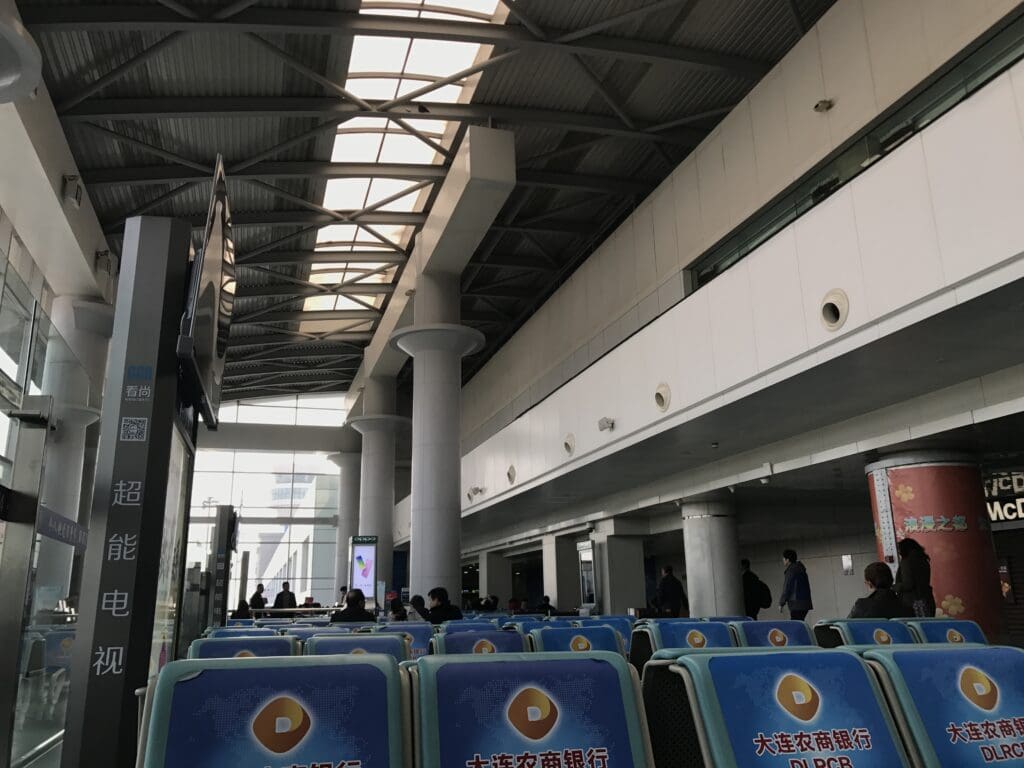
Looking outside, the usual SkyTeam culprits, China Eastern Airlines and China Southern Airlines, seemed to make up a significant portion of the movements. However, in addition to these a selection of aircraft and airlines that I was less familar with could be seen coming and going. These included a fair number of Boeing 737-800 operated by Air China’s local subsidiary Dalian Airlines, along with several China Express Airlines Bombardier CRJ-700s, a few jets from Hebei Airlines and a luxury Deer Jet Boeing Business Jet. Alongside these, two Boeing 737 Classic Freighters operated by CR Cargo and China Postal Airlines were also seen waiting in between missions. However, the undoubted highlight touched down at 0825 and came in the form of a China Flying Dragon Aviation Harbin Y-12. Later research revealed that this operates short hops between Dalian and the island of Changhai.
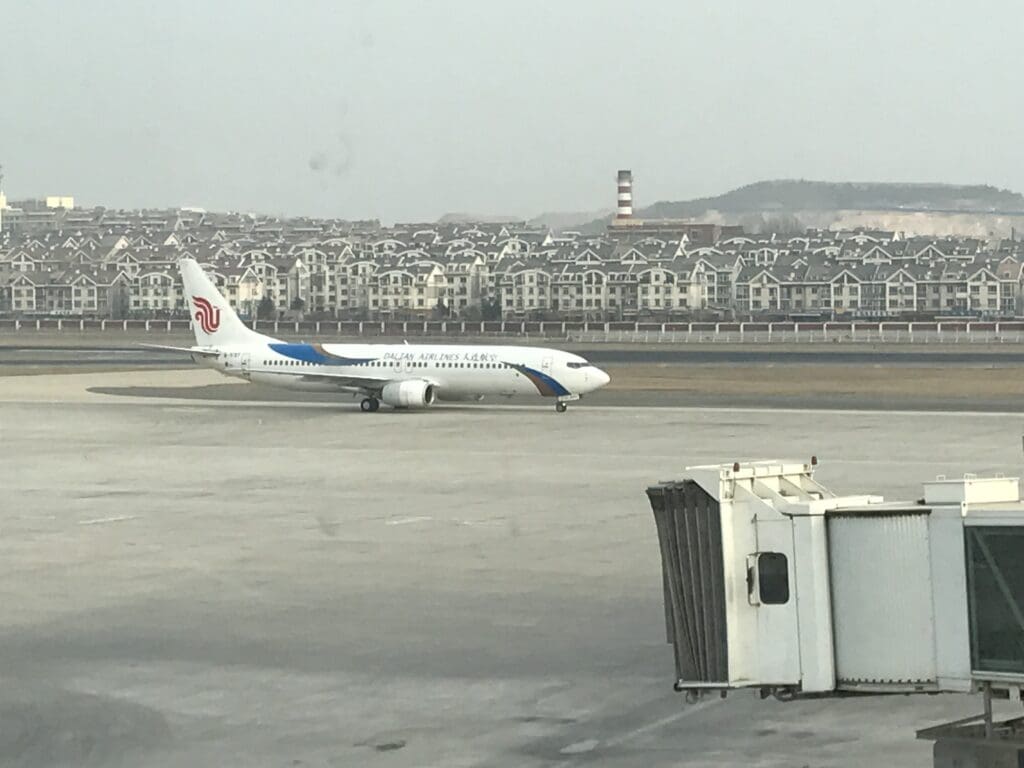
For those not so interested in planespotting, inside the terminal plenty of shops and restaurants can be found. Almost an hour prior to our scheduled departure time, I caught sight of the rare and distinctive Xian MA60 touching down in Dalian and ending its short flight from Yantai. As with my ride up to Dalian, once again, this aircraft sported the orange and white livery of Okay Airways, however, I was delighted to find that this came in the form of a different aircraft, B-3715 to be precise. Just like other Xian MA60s, details on the aircraft’s history were scant. However, with the construction number of 915, this was manufactured in 2012 and was thus around five years old at the time of my flight. Once again, I presume that this aircraft had operated for Okay Airways until the type’s sudden withdrawal from their fleet and their transfer to Joy Air several months earlier.
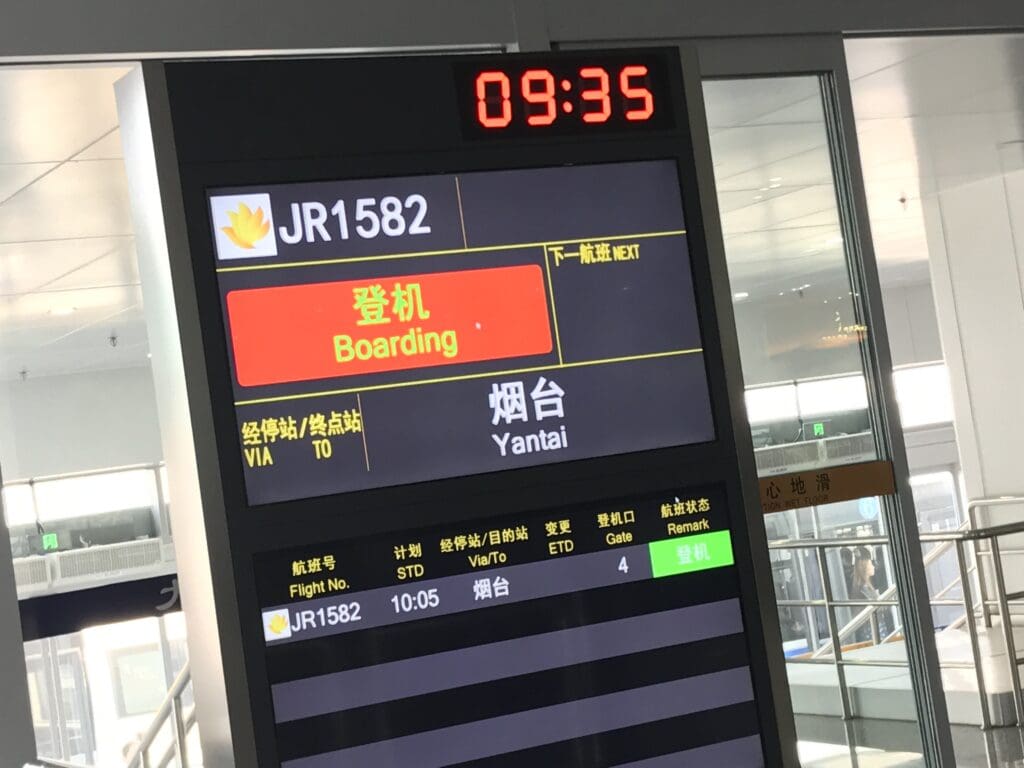
That morning, boarding was scheduled to commence at 0935, and with the aircraft parked at a remote stand, this was to be undertaken via a bus. With fifteen minutes to go until this was to begin, I made my way down to the bus boarding gates which, with three other flights departing in quick succession, I found this to be rather busy with few places remaining available for passengers to sit and wait. Had I not wished to head to Yantai, I could have instead made my way to Kunming via Nanyang, Shanghai Pudong, or Shenzhen via Ningbo. At 0935 on the dot an announcement was made in Mandarin and English inviting those bound for Yantai to board, and so I joined the short queue before having my boarding pass scanned and my passport checked. With all passengers making it to the gate in a punctual manner, with 34 fellow passengers, the bus doors soon slid closed and we commenced our short ramp tour. This took us on a short ramp tour, before arriving at the Xian MA60 that was sandwiched between a China Express Airlines Bombardier CRJ-700 and a Xiamen Airlines Boeing 737-800.
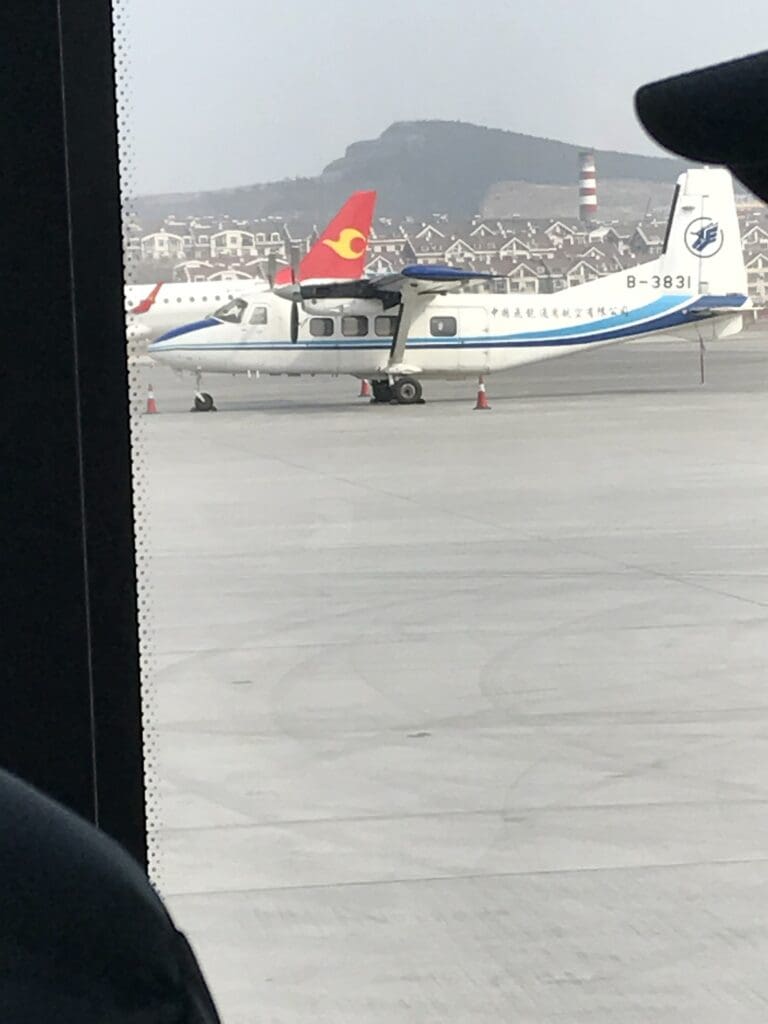
Upon coming to a halt, the bus doors remained closed as an army of ground workers appeared to be readying the aircraft in preparation for its return flight to Yantai, whilst another worker, presumably the dispatcher, shuttled in and out of the aircraft. After waiting for a few minutes, the driver opened the bus doors and passengers spilt out onto the apron, soon congregating around the rear of the aircraft with only one passenger being allowed on the rickety ladder at any given time. A short time later, I ducked once again so as to avoid hitting my head on the door frame before entering the spacious area at the very rear of the aircraft.
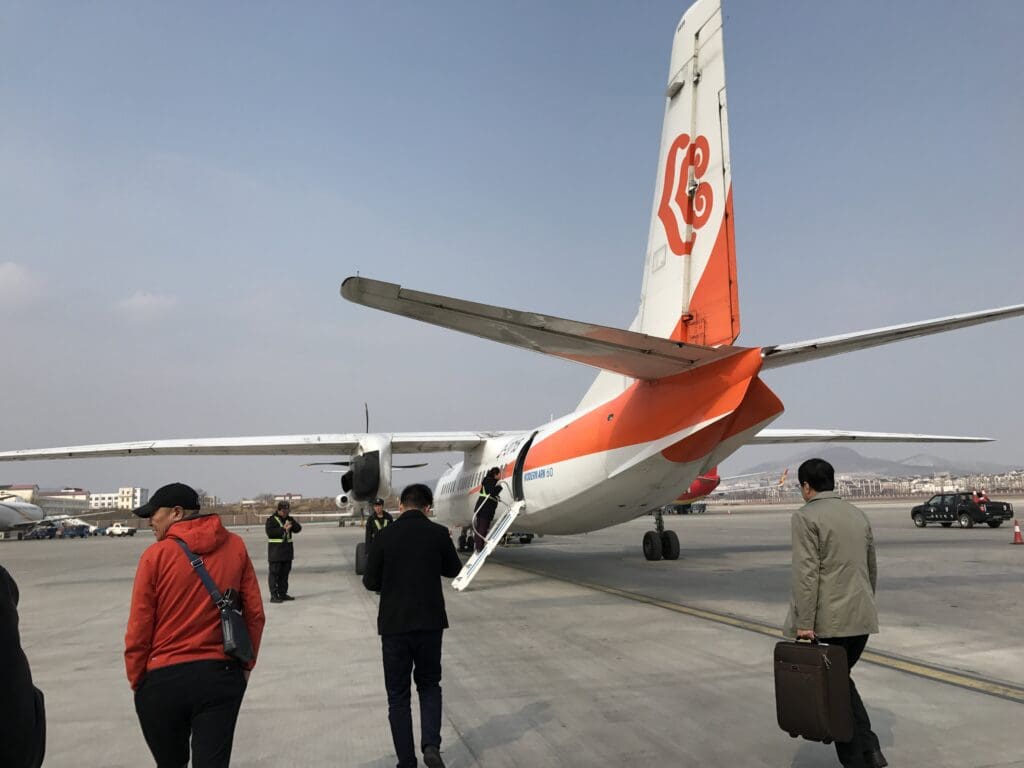
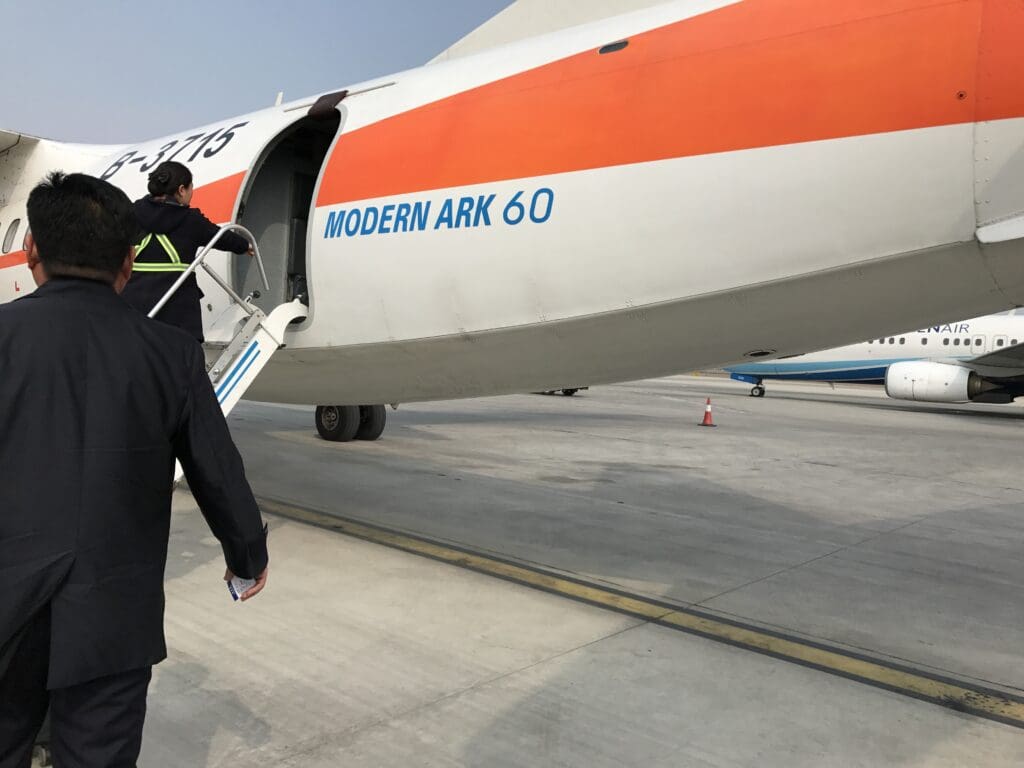
Once onboard, I was immediately hit by the heavy scent of oil that is more commonly associated with a vintage propliner rather than a five year old turboprop! Unlike on my previous flight, the aircraft’s sole flight attendant remained silent during the boarding process rather than welcoming passengers as they climbed onto the aircraft. Thus, without a greeting, I turned left and made my way through the one row of Business before arriving in the Economy cabin. For the most part, the cabin was identical to that of the aircraft that I had flown the previous day, the only difference being the antimacassar which this time featured Joy Air’s logo rather than that of Okay Airways, accompanied by an advertisement for Weizhi, a clothing company. Meanwhile, each seatback pocket contained Joy Air’s safety card, a sick bag that thanked passengers for flying with ‘our airline’ (I assume this was a generic message rather than a leftover sickbag from Nauru’s previous flag carrier) and a small promotional booklet for Huashan City in Anhui Province. Last but not least a small bottle of water had been placed in each seat.
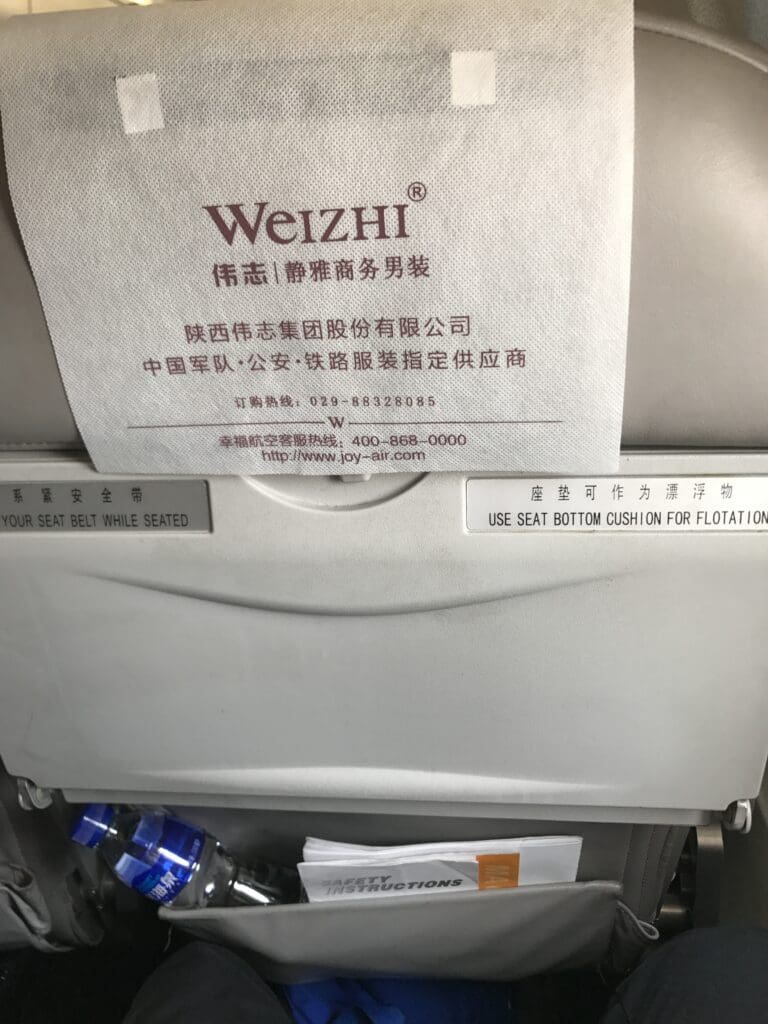
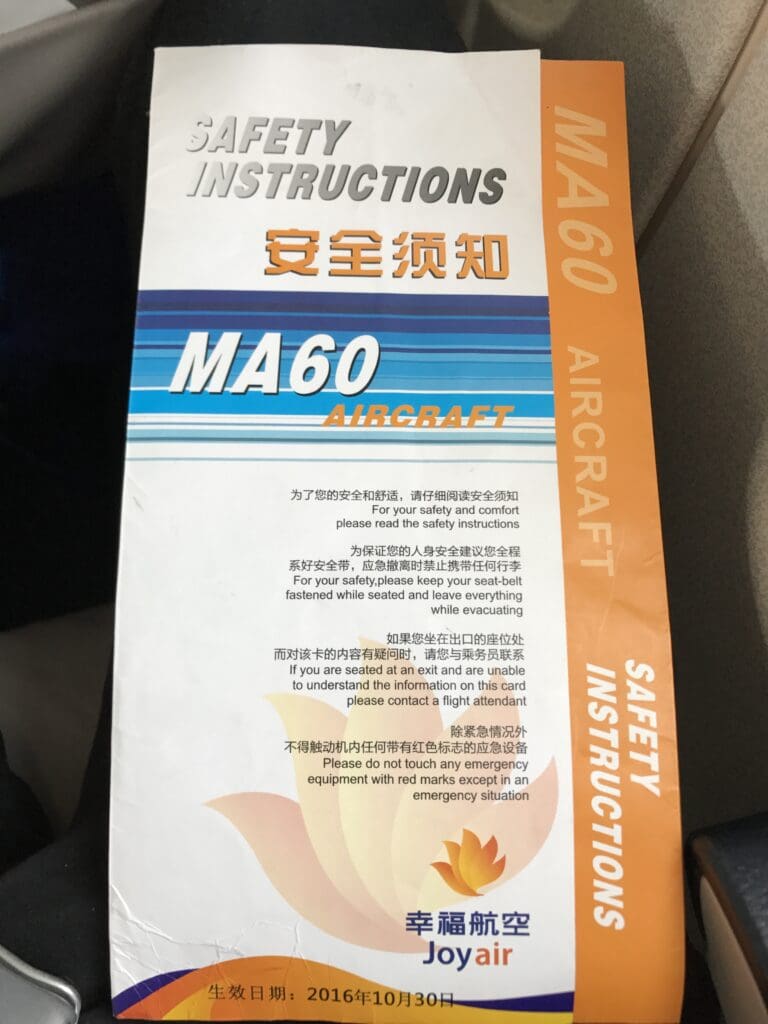
Seeing as I would be making the journey to Yantai in the rearmost Economy row, I arrived at my seat in a matter of seconds, by which time my neighbour had already strapped themselves in to Seat 12C. Refusing to stand in order to allow me to pass, I had to awkwardly climb over this passenger before slithering into my seat. As I had expected given my ride the previous day, I found the seat to be firm and for the most part uncomfortable, and, whilst clean, this did feature a fair few marks and scratches. However, on the plus side, the legroom in Seat 12D seemed to be slightly better than that offered by my seat at the front of this aircraft. Crucially, this aligned well with the window, allowing me a good view of both the world outside and the rear of the engine.

Only ten minutes after the had left the terminal behind, the stairs were retracted and the cabin door was closed with a loud thud before the flight attendant made their way to the front of the cabin to demonstrate how to fasten seatbelts as the pre-recorded safety announcement rang out in Mandarin and English. Once done, the flight attendant then passed through the cabin ensuring that all was set for our departure as our two Pratt and Whitney engines spooled into life, once again creating plenty of noise and vibration. Upon spooling up, the aircraft remained on stand for a good five minutes or so before lurching forwards and commencing its journey to the end of Runway 28.
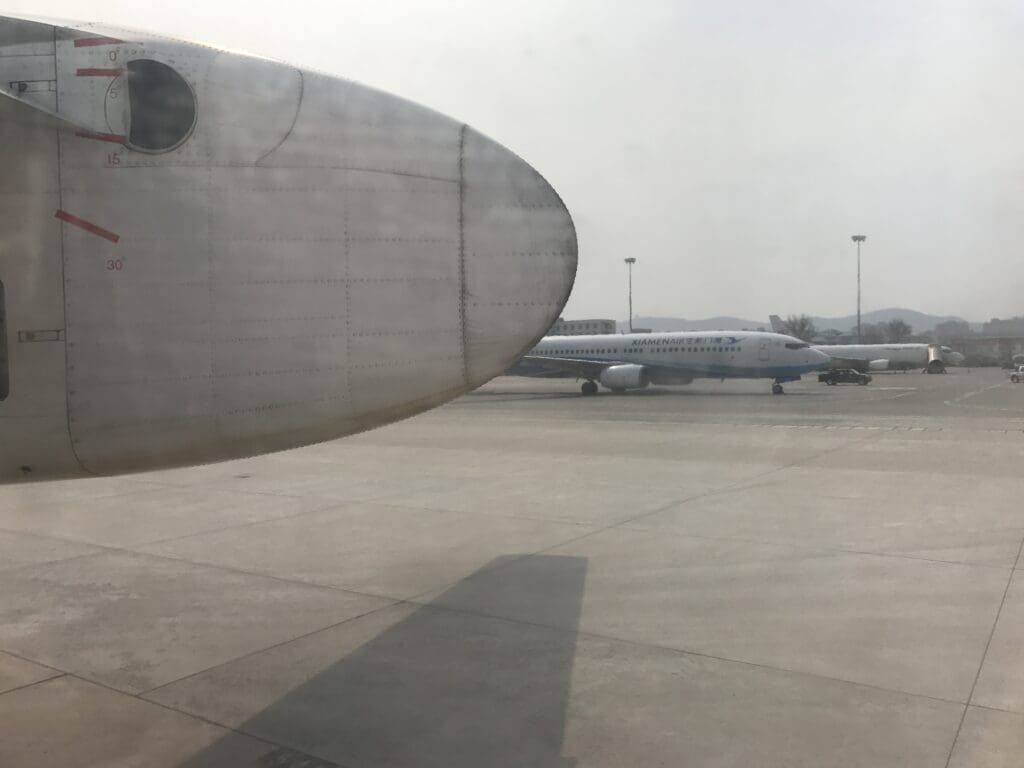
During our short taxi, the Xian MA60 made its way past the terminal where a single international visitor could be seen. This consisted of the aircraft that I had considered taking back to Korea, an Asiana Airlines Airbus A321 which was being readied for its short return hop back to base. Upon leaving the terminal behind, the aircraft made its way past China Southern Airlines’ maintenance facilities, a cluster of modern business jets and what at first glance appeared to be an Antonov An-2. However, this was instead a rare vintage Nanchang Y-5, the locally produced variant of this venerable biplane.
Departing during what seemed to be a quiet time, that morning no holding was required before we made our way onto the runway. Without pausing, at 1004, one minute before our scheduled departure time, the two turboprop engines spooled up resulting in plenty of noise and vibration as we went flying down before soon rocketing upwards into the partially clear skies. Within a matter of seconds, the Xian MA60 crossed over Dalian Airport’s perimeter fence and climbed over the rows and rows of apartment blocks, both new, tall and fancy, and older and more modest, that sit around the airport. Unfortunately, the aircraft soon passed through a thin layer of cloud that prevented further views of Liaoning before we turned onto a southerly heading and commenced our journey over the Bohai Strait. A relatively short time later, the aircraft levelled off and commenced its smooth if not very vibration filled cruise.
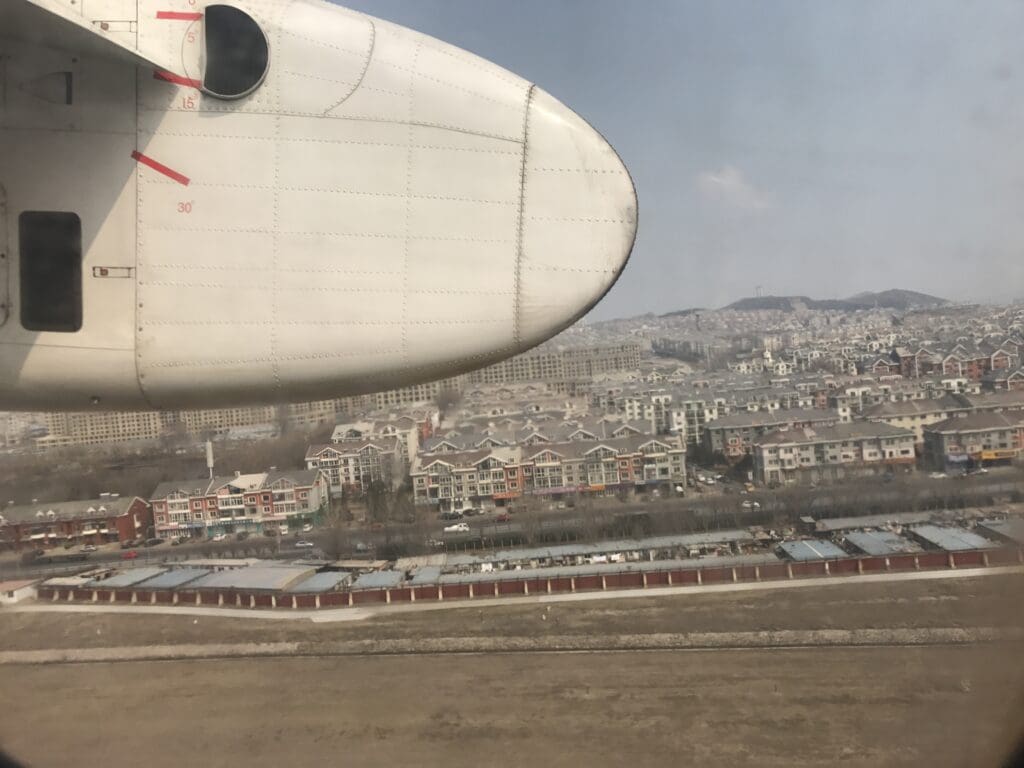
With nothing to see outside other than the aircraft’s port engine and the clouds below, and with no inflight entertainment, seeing as my neighbour had jumped up to speak to another passenger at the front of the aircraft, I decided to make a visit to the toilet at the rear of the aircraft. Fearful of some harsh words from the flight attendant for moving about whilst the seatbelt sign remained firmly illuminated, upon reaching the rear of the aircraft, I realised I had nothing to fear as the sole flight attendant was slumped in the jumpseat, blanket on lap, fast asleep!
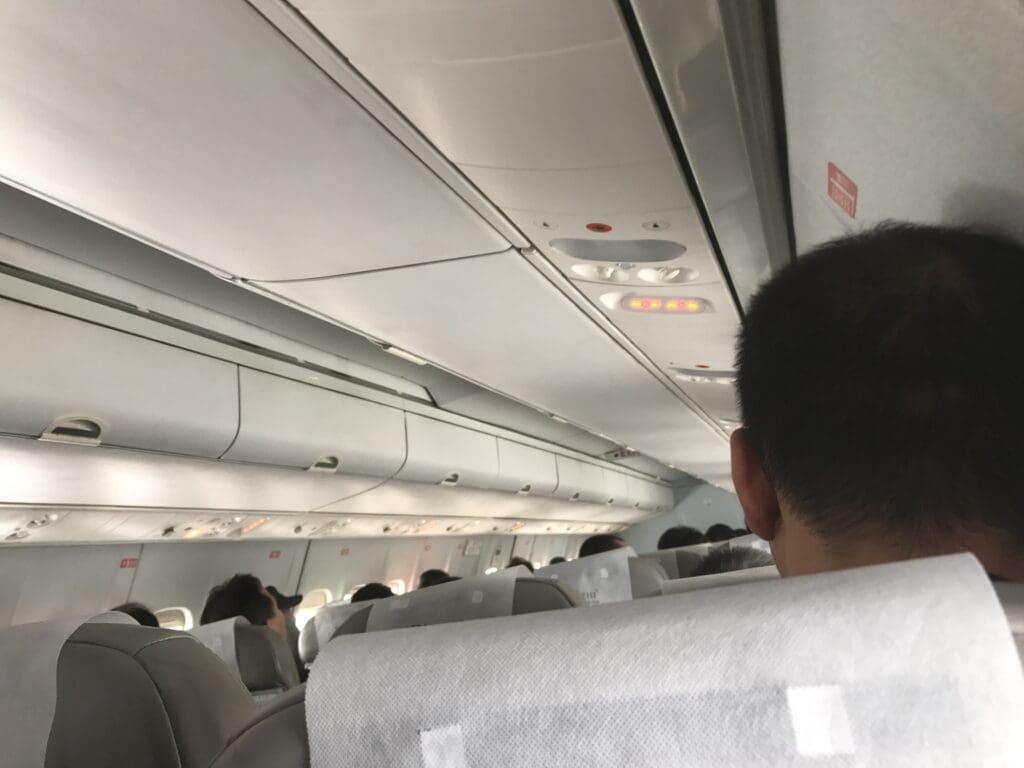
Just like on the Antonov An-24, the Xian MA60’s lavatory is stuffed into the rear galley as if it had come as an afterthought for the aircraft’s designers. Not expecting a particularly spacious or luxurious toilet, upon opening the door my expectations were matched as I contorted myself into the dark and dingy lavatory. Unfortunately, this appeared to be far from clean and had a rather overbearing unpleasant stench, furthermore this lack both water and soap. However, all was not doom and gloom and the lavatory was complete with a single communal comb and tissues.
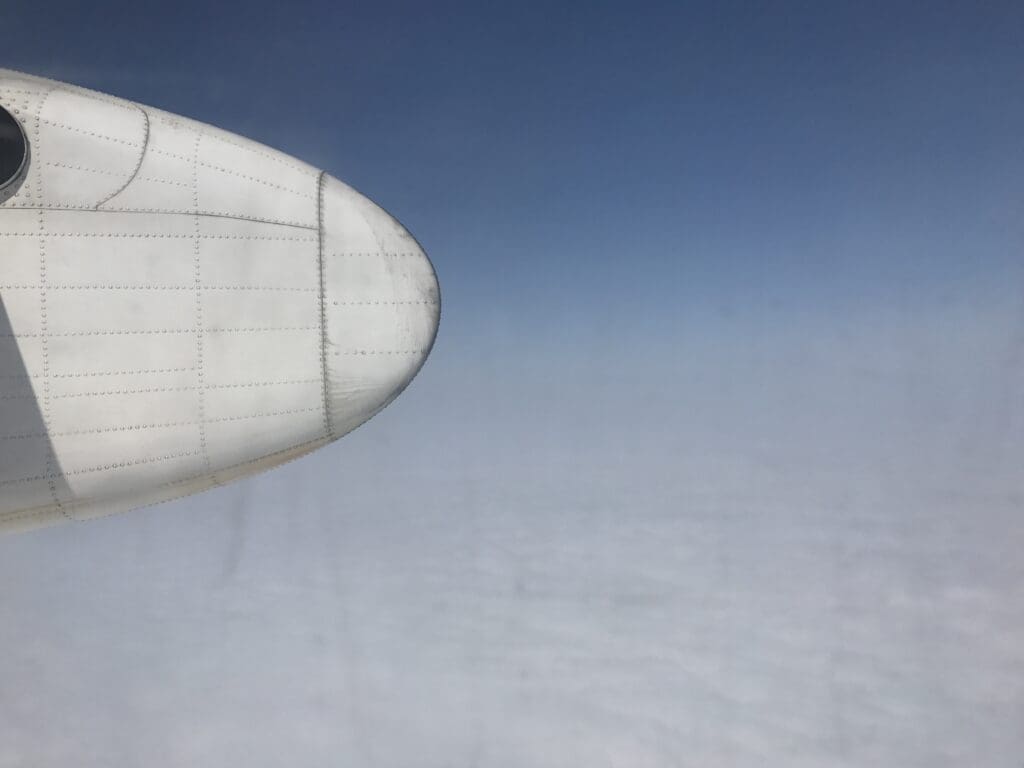
Following a quick trip, I headed back into the cabin by which time my neighbour had settled back into their seat. Fortunately, perhaps realising the awkward situation he had created during boarding, he was more than willing to temporarily stand in order to allow me into my seat. Once settled in and buckled up again, the aircraft could be felt sinking back towards Earth and soon the pre-recorded descent announcement loudly rang through the cabin in Mandarin and English. Thankfully, by this time the flight attendant had woken up and was now passing through the cabin checking passengers’ seatbelts albeit, like the boarding process, going about their duties without a single word.
Soon enough, the Xian MA60 sank down into the clouds and we were thrown around a little before five degrees of flaps were added and our landing gear was extended with a loud clunk in preparation for our arrival. Eventually, the aircraft emerged from the clouds and revealed the near freezing rural landscapes below where a mixture of fields, industrial estates and small towns could be seen as we bounced around a little on our journey towards Yantai Penglai International Airport. Just as had been the case in Dalian, soon, the aircraft seemed to make a steep-ish dive towards Runway 22. After passing over fields, a motorway and some more fields, the aircraft whizzed over the perimeter fence before touching down with quite a bump at 1043, bringing an end to our short 39 minute flight.
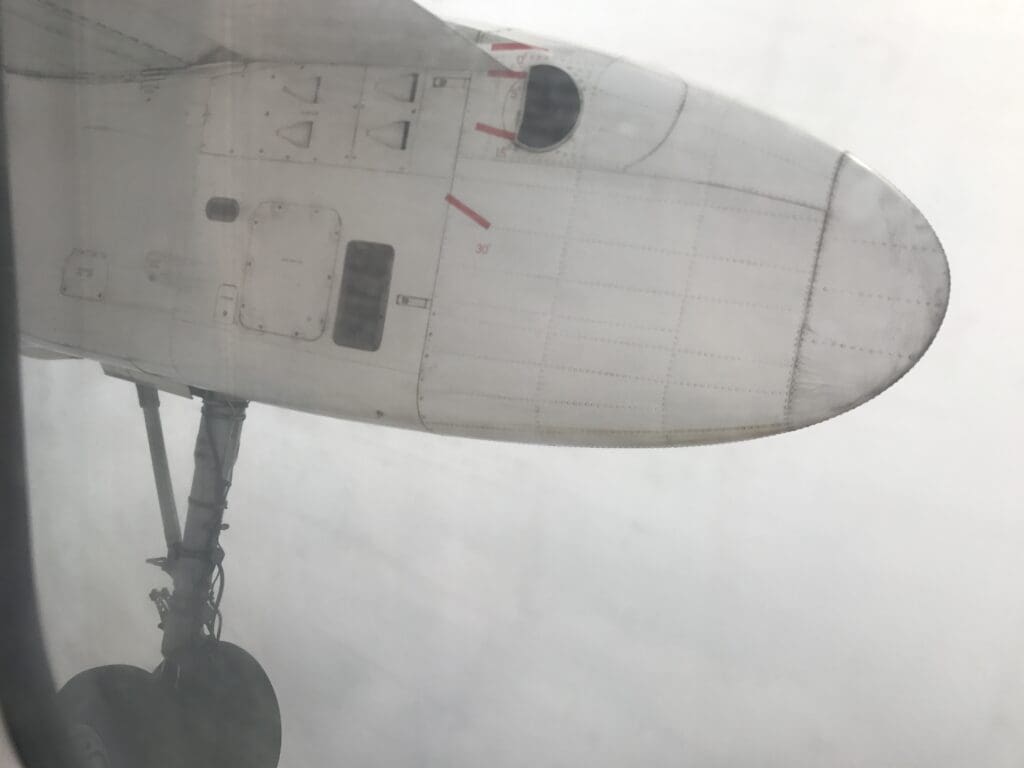
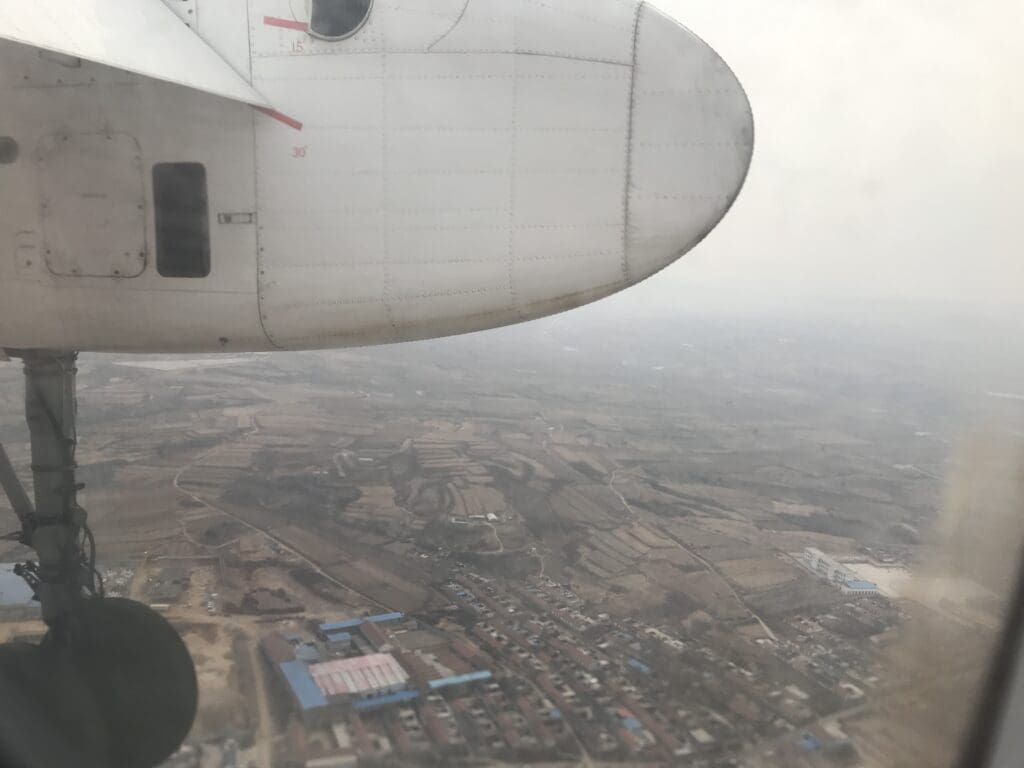
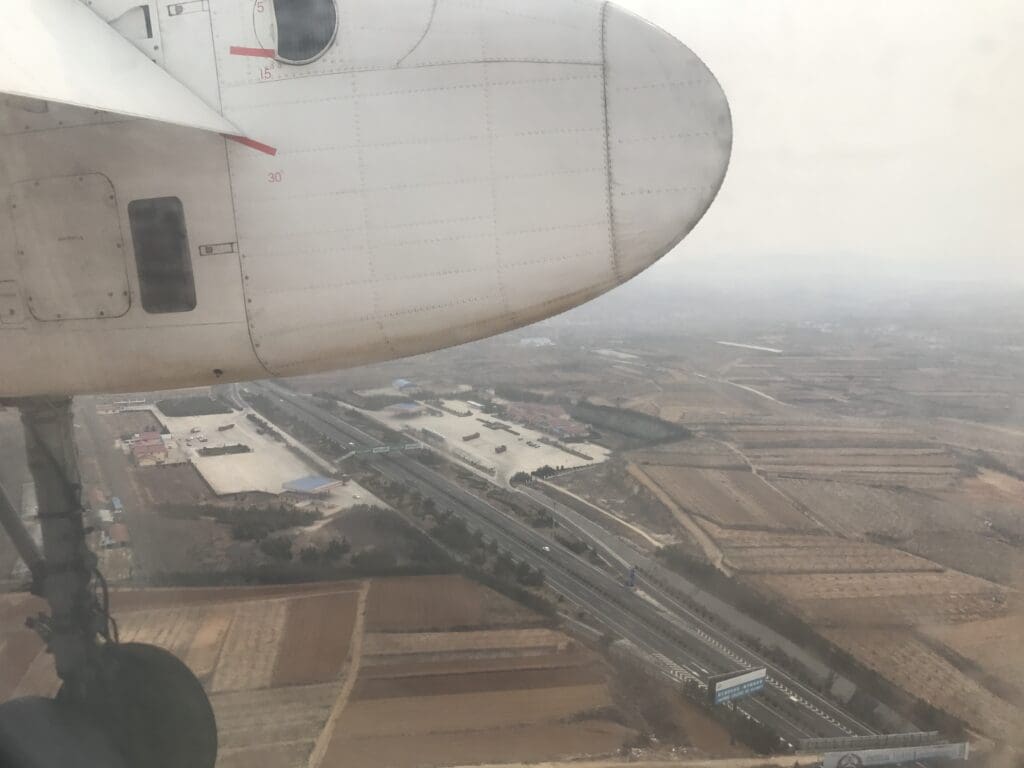
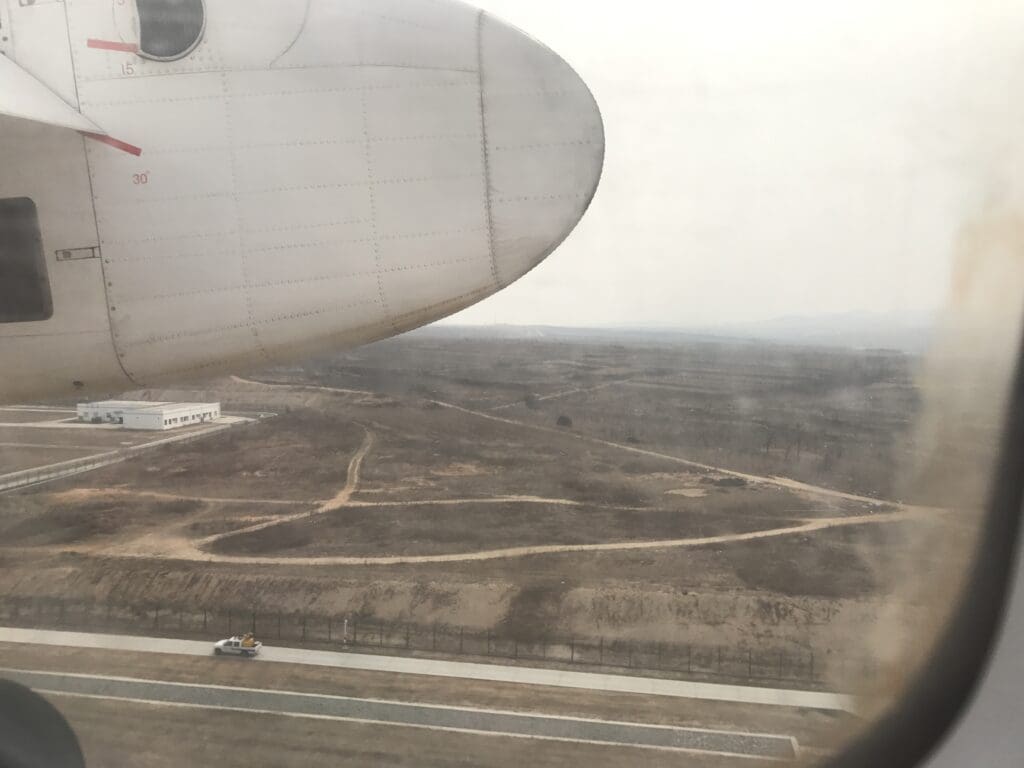
Once back on the ground, the Xian decelerated rather gently before we vacated the runway and made our way towards Yantai Penglai International Airport’s modern terminal building. Arriving during a rather quiet time in the middle of the day, there, no more than two aircraft could be seen, an Air China Airbus A320 and a Shandong Airlines Boeing 737-800. However, a more interesting visitor could be seen at a remote stand in the form of a rather well-polished and clean-looking Cessna 560XL operated by the Civil Aviation Administration of China.
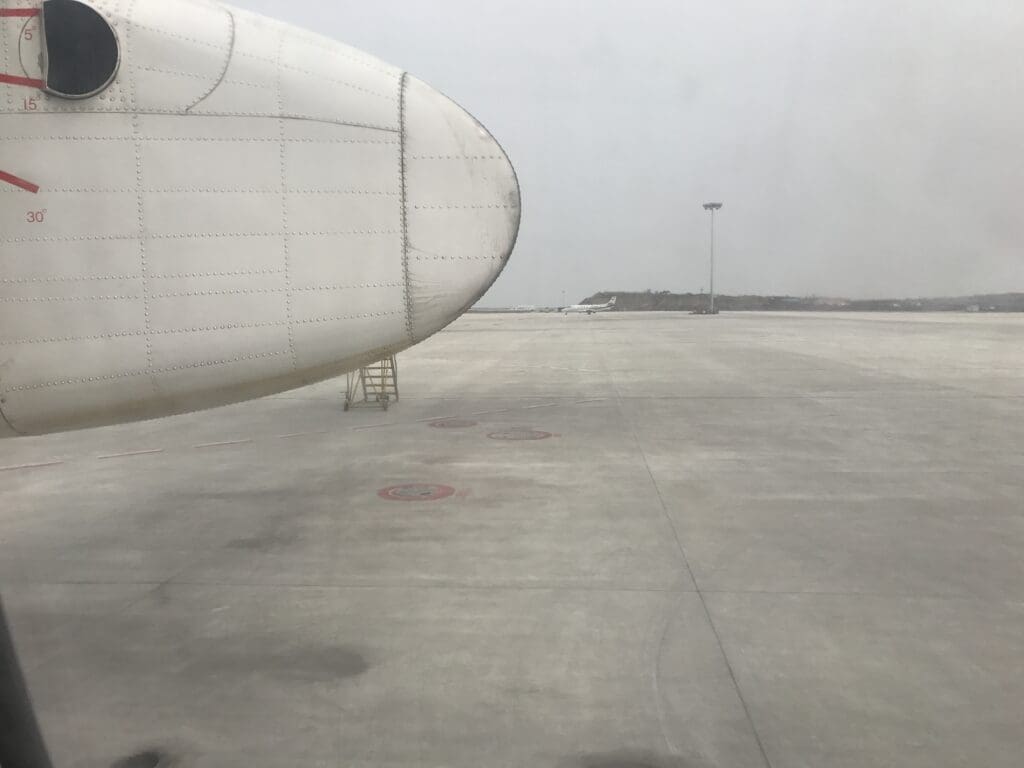
Following a very short taxi, the aircraft came to a gentle halt at Stand 310 and the two engines spooled down, causing near total-silence to fill the cabin. Seeing as plenty of ground staff were ready and raring to get to work once we came to a halt, and a bus was already waiting and ready to shuttle passengers over to the terminal building, in a mater of moments, the cabin door was opened and disembarkation commenced. Soon standing up, I made my way through the miniscule Business cabin before reaching the rear galley where the flight attendant could be seen watching over passengers as they disembarked, whilst not offering any sort of thanks or farewells. Soon, I made my way down the aircraft’s rickety built-in steps and made my way onto the apron before heading the short distance to the waiting bus.
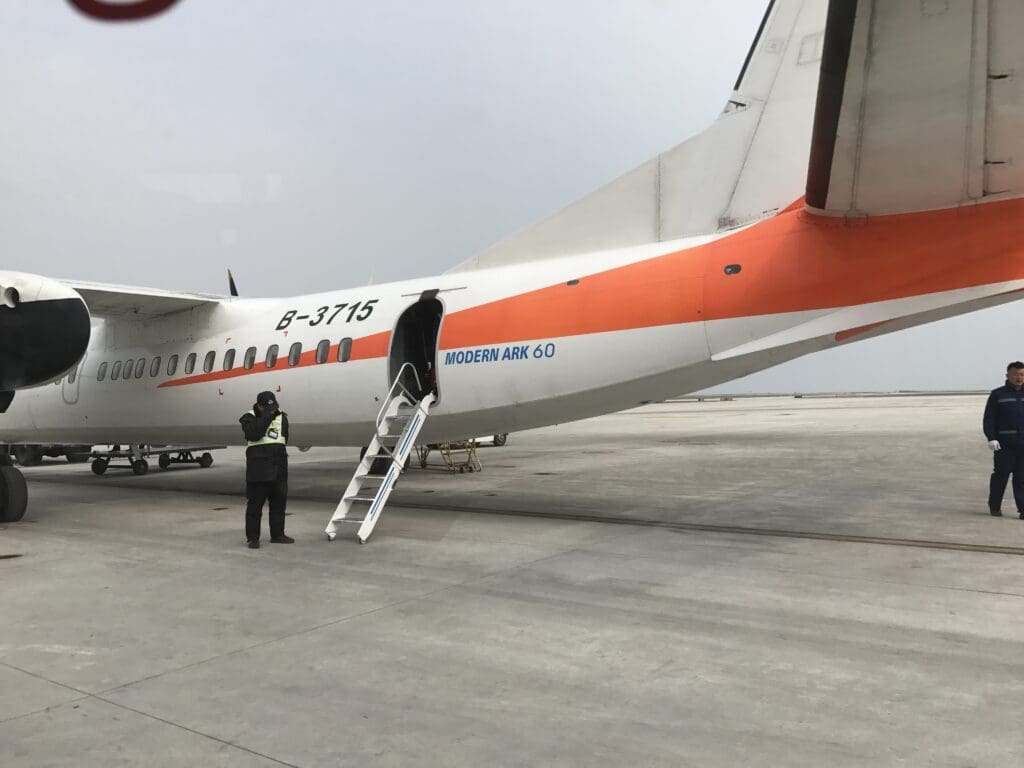
Once the final passenger had disembarked, both pilots made their way out of the aircraft and slightly worryingly began to intensively inspect the aircraft’s port engine along with an engineer. Meanwhile, a single cleaner boarded the aircraft, readying it for its next load of passengers. After observing this scene for a moment, the bus doors slid closed and we headed towards the terminal, arriving there within a couple of minutes. Once inside, I sped through the baggage collection hall, quickly arriving back in the landside area after my exciting jaunt on the Xian MA60.
Summary
Were I a regular passenger and expecting the comforts of the Airbus A320 or Boeing 737-800, the chances are I would most likely have been somewhat disappointed with my two flights on the Xian MA60. The aircraft was neither the most comfortable in the world, nor was it the most quiet and both examples appeared to be somewhat battered and worn, despite the fact that they were still relatively young. However, of course, I am most definitely not a regular passenger and flew to China just to sample this rare aircraft. Thus, I can safely say that I was not disappointed in any way, shape and form. Whilst the type may never be a favourite amongst its operators, I sincerely hope to see the MA60 flying in the skies for years to come.

